75 years in the service of science
Søren Laurberg
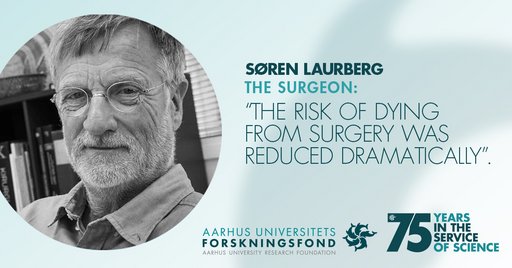
The surgeon:
’The risk of dying from surgery was reduced dramatically’.
Clinical Professor Søren Laurberg became fascinated with surgery when he, as a young man, did his internship in Odder. He later became an internationally acclaimed capacity within intestinal surgery.
My first big eureka moment was when I, after having given radiotherapy to the brain (hippocampus) of new-born rats through a microscope at the Department of Anatomy, realised that all nerve connections to the cells that had disappeared due to the radiotherapy continued to be organised in the same way. That is, the organisation of nerve connections does not depend on the presence of the recipient cells, and the discovery made me think that I would spend my life doing basic research into the development of the brain.
My second big eureka moment occurred when I was training to become a surgeon and reading a book on changes to the nerve supply to the pelvic floor after giving birth, published by the world-famous London hospital, St. Mark’s Hospital. My career changed when I suddenly realised that I could use all my basic nerve-related knowledge in my future work as a surgeon, and it made me travel to London and subsequently focus on a highly specialised academic surgical career in intestinal surgery.
What led to both eureka moments was reading about new discoveries that triggered my curiosity. First, a scientific article proving a change in memory in rats after radiotherapy to the hippocampus, which I red at the library at the Department of Anatomy, and second, an advertisement for a new book in the British Journal of Surgery.
I felt most diluted when I had made a scientific study that showed that patients who had undergone surgery but no radiotherapy for rectal cancer had a very small risk of subsequently developing intestinal complications. I did not realise until later that the only reason for this was that surgery for rectal cancer could cause significant intestinal complications.
I knew that I wanted to work within this field when I, as a newly appointed assistant professor at the Department of Anatomy, took a leave to do my internship – for the sole purpose of getting more clinical experience to use in my teaching. When I did my internship in Odder I became really interested in surgery due to the close contact with the patients, the important decisions you have to make and the fact that you soon get a clear sense of whether your decision was the right one.
My research is relevant to other people because the greater majority of my research has been patient-based clinical research and the results have been vital to patient treatment and check-up.
I received support from the foundation for studying whether patients experienced fewer complications if they were treated with EPO in connection with surgery for intestinal cancer. The rationale was that EPO given before surgery for intestinal cancer could lead to the formation of new red corpuscles, compensating for blood loss during the operation. The study was one in a series of scientific studies which caused the risk of dying from surgery to drop dramatically from approx. seven per cent to just one percent, and which caused patients to be discharged and to recover much faster.
Support from the foundation meant that we were able to conduct a large national double-blinded, randomised controlled trial of EPO among patients with intestinal cancer. The study showed that EPO does not benefit these patients.
I am most proud of my work when I can see that my clinical and scientific work has radically improved surgical treatment for intestinal diseases – causing Denmark to move from the bottom to the top of the global league in less than 15 years.
Right now I am doing a large national study on late complications associated with treatment for pelvic cancer – that is, intestinal, bladder, abdomen and prostate cancer. We are trying to identify late complications, the need for treatment and the best possible treatment, ensuring that the patients not only survive, but can live a good life. We have been pioneers in this field, and at national as well as international levels researchers are now acknowledging the need to focus on quality of life following improvements in the treatment for cancer.
My other major area of interest is molecular biological studies. For 20 years I have been the ‘clinician’ who has helped molecular biologists Torben Ørntoft and Claus Lindberg Andersen get the cancer tissue required to better understand intestinal cancer tumours. It has become really interesting now, as recent studies indicate that we are able to identify the patients who, following surgery, have a high risk of developing new tumours – and to offer them oncological treatment.
BIOGRAPHY
Søren Laurberg
Clinical Professor at the Department of Clinical Medicine, Aarhus University, since 1998.
Holds a Master of Science in Medicine from 1977 and a DMSc from 1983.
Support from the Aarhus University Research Foundation in 2002 for studying the effect of Epoitin in connection with surgery for intestinal cancer.
Th. Geiger

Dr Klaus Rodax says about Th. Geiger:
’He urged us to be alert to the tyranny of ideologies’.
German Th. Geiger (1891-1952) became a political refugee and Denmark’s first professor of sociology in 1938 after having been fired by the Nazis from the university in Braunschweig for ‘national unreliability’, says Geiger expert Dr Klaus Rodax.
Th. Geiger’s biggest eureka moment was a realisation that made him stand out from the sociologists of his time: Sociology is basically political and serves to renew society. His interest in the field was driven by socio-political questions; this is evident from his first German studies of crowds in revolutionary times of change through e.g. his studies of competition and advertisement, morals and ethics, the job and position of the intelligentsia as well as his empirical studies of Denmark’s layer and class structure to his study of democracy. Geiger was always both the sociologist, who merged his social theoretical and social empirical ambitions with social statistics and social philosophy into an academic position, and the social debater who spoke on public as well as social pedagogical matters.
What led to this realisation was a ground-breaking study of Germany’s social layers, ‘Die soziale Schichtung des deutschen Volkes’ from 1932. Here he took more drastic action than in his previous theoretical and empirical accounts of the social classes and identified, for the first time, five social statistical layers: the capitalists, the old middle class, the new middle class, the ‘proletaroids’ and the proletarian. He studied the classes socio-graphically focussing on the new social awareness of the various layers, on mentalities and ideologies. In a digression, Geiger also studied the middle classes’ political-ideological tendencies and inclinations under the rule of National Socialism. According to Geiger, especially the many workers would turn on Hitler and the NSDAP, as the employers’ interests would move in the direction of a joint trade union initiative. Unfortunately, this class theoretical argument proved erroneous.
He must have felt most diluted when he in his early work still believed Marxian-based class theory with its two layers – that is, the opposition between the capitalists and the proletarians – to characterise the class society. The old and new middle classes were, as a result of the conflict between the capitalists and the proletarians, destined to be torn to pieces. But his doubts regarding the Neo-Marxian two-class theory and the bourgeois three-class theory grew, as none of them appeared to have much basis in reality, and he therefore began to sharpen his theoretical conceptual tools and subject them to thorough empirical and analytical inspection.
He became hooked on the field when he, in connection with his sociological work on workers, confessed to the idea that ‘Realisation means: to understand things objectively based on their own structure, not by interpreting them subjectively … Science, that is the personal and spiritually liberating and cumulative pursuit of objective realisation, this search for truth that hides in things’ (1921). This understanding of science would serve as common thread in his work and result in his adoption of theoretical and practical value nihilism.
His research is relevant to other people because he in his discussions sharpened our view of how one – regardless of a prevailing social metaphysics and brotherhood-like glorification – should study social issues. He studied society’s differentiation in layers and classes and expanded the existing knowledge of the topic, in theory as well as in practice, e.g. when he in his Danish studies included political theses on democracy, social openness and mobility. He thus made scientific contributions to unprejudiced thinking within legal sociology and urged us to be alert to the tyranny of ideologies.
This portrait of Th. Geiger has been translated from German by Gert J. Fode, who has also translated several of Geiger’s books from Danish into German.
BIOGRAPHY
Th. Geiger (1891-1952)
Denmark’s first professor of sociology in 1938 at Aarhus University. Co-founder of the Department of Political Science at Aarhus University, the International Sociological Association and the Danish Sociological Association of which is also served as president for a number of years.
Held a degree in philosophy of law and political science from Munich and Würzburg 1914. Five years later he became a Doctor of Law.
Support from the Aarhus University Research Foundation in 1946 for a ’History of Ideas and Idea Critical Study of the Concept of Freedom’.
Therese Ovesen
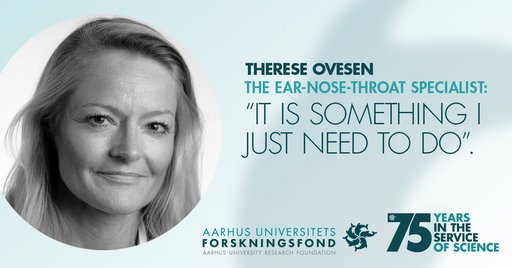
The ear-nose-throat specialist:
’It is something I just need to do’.
Clinical Professor Therese Ovesen did not plan on becoming a researcher when she trained to become a doctor. Today she cannot imagine a life without the unique dedication of the research process.
My biggest eureka moment was when I realised that research is part of my DNA. Finding the answer to a question and pursuing an idea is something I just need to do. An example of such a question is whether draining the ears of children is solely a good thing – and it is not. In other words, we learned that you have to think carefully before performing the treatment, as there are long-term consequences.
What led to this realisation was that such influence on the development of a research process – from idea to result – gave me a unique dedication and not least satisfied my curiosity.
I felt most diluted when I as a student of medicine was tasked to do research that had been planned by others – and asked to complete something that was not even half-finished. It seemed pointless to me, and it failed to arouse my curiosity. Therefore, I actually decided before graduating as a doctor that I did not want to do research.
I knew that I wanted to work within the ear-nose-throat area when I had to choose a clinical major after four years of research working as a clinical assistant. Originally, I had been interested in a different area of specialisation, but as my research-based knowledge grew, so did my interest in this area of specialisation.
My research is relevant to other people because it focuses on something that a lot of people suffer from and which affects the quality of life of the individual patient. An example is the fact that as many as one third of those who lose their sense of smell develop depression and/or anxiety symptoms. Their ability to enjoy food and drink disappears, and they do not sense e.g. that the Advent wreath, the food in the oven or the bread on the toaster is burning.
I received support from the foundation for studying what happens in the middle ear mucosa when there are fluids in the ear and it is treated with a drainage tube.
Support from the foundation meant that I, also with support from other sources, was able to complete all the projects for my higher doctoral dissertation.
I am most proud of my work when a research result leads to improvements – whether big or small – in diagnostics and/or treatment of patients.
Right now I am studying the microbiome – that is, all the microorganisms that live inside us – and its impact on our sense of smell, and how it affects infection with e.g. corona virus.
BIOGRAPHY
Therese Ovesen
Clinical Professor, Consultant Doctor, Department of Clinical Medicine and the Department of Ear-Nose-Throat Surgery, the Regional Hospital Unit West Jutland.
Holds a Master of Science in Medicine from 1986 and a DMSc from 1996 from Aarhus University.
Support from the Aarhus University Research Foundation in 1990 for the project ‘Tissue Cultures for Study of Middle Ear Tissue Partly Under Normal and Partly Under Pathological Conditions’.
Daniel Rötter
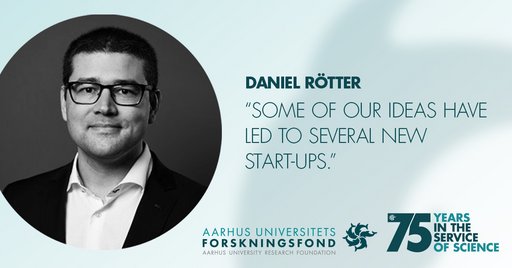
’Some of our ideas have led to several new start-ups’.
Associate Professor Daniel Rötter researches the way we share and store data. And even though it is an invisible field of research, it is immensely important to the everyday lives of a lot of people. Among other things, because it focusses on how the Internet works.
My Biggest Eureka Moment was probably when I discovered a new way of conceptualising and representing data that may change the way we transfer, share, store and learn from the data – using significantly fewer technical resources. However, with each problem comes a small eureka moment when you truly understand the main question and gain the insight required to answer it, sometimes long before you have an actual solution.
Two things led to this recognition. First and foremost, several years’ work questioning the way we effectively communicate, process and store data. In addition, I was inspired by something outside my research field to rethink the existing ideas of and design solutions to challenge them. For example, we challenged the idea that accessing specific data in a compressed file is impossible without decompressing the entire file – that is, a bit like the zip files on your computer. Today you have to unzip the entire file to access a specific part of one of the files inside.
I must have felt most deluded when one of my areas of research after 10 years’ work began to feel a bit too easy. The work was still interesting, and we were still developing unorthodox ideas and solutions that made a difference. But some of the excitement about the unknown had begun to fade. Fortunately, this changed when I began to work on a new area that led to new ideas and new excitement.
I knew I wanted to work on data research at a relatively early point in my career. I had fairly broad interests which did not fit well with either software coding or electronic development, but then I realised that I did not have to choose between the two. I could use my experience from both areas in my research. And this combination has actually proven to be a great advantage, as software development to a great extent defines the development of hardware today. And that is also why I enjoy collaborating with both mathematics and computer science researchers.
My research is relevant to other people because research into data and computer technology affects their everyday lives, even if they are unaware of it. Our research affects the design of communication networks and cloud systems and the way we create stability and compress stored data. All of this is vital to how well the Internet works – including both various cloud systems and the applications that people all other the world use to communicate with each other. Some of our ideas have led to several new start-ups and been integrated in the products of large international companies.
I received support from the foundation to establish a new research group when I first arrived at Aarhus University in 2017. We research how future networks and cloud technologies are affected by computer networks, computational power and data storage.
Support from the foundation meant that I was able not only to start a new laboratory, but also to fund main research areas and some promising young researchers. Overall, this led to one of my eureka moments concerning the way we transfer, process and store data. For that I am very grateful.
I am most proud of my work when I discuss it openly with my students and fellow researchers. When we develop simple, but interesting models for our main theories. When we test these models in real life by implementing them in software and sometimes in hardware. When we learn whether our ideas work in practice or how we need to adjust our models or understanding of the research area in question. In other words, when we really try to understand and solve a problem in practice.
Right now I focus on developing a new theory for representation, indexing, computation and storage of data – and on developing practical solutions within a number of areas. For example, we are trying to determine how we can reduce data traffic from the Internet of Things tenfold – that is, from refrigerators connected to the Internet, for example – without losing valuable information. We are also trying to develop cloud systems with reduced energy consumption which contain fewer servers with the same amount of information. Our ultimate goal is to reduce the global emission of CO2 from computers and data networks.
BIOGRAPHY
Daniel Enrique Lucani Rötter
Associate Professor at the Aarhus University School of Engineering.
Holds a PhD in Electrical Engineering from the Massachusetts Institute of Technology (MIT), 2010.
Support from the Aarhus University Research Foundation in 2017 in the form of an AUFF Starting Grant.
Mogens Nielsen

The Computer Scientist:
’There was only one electronic calculator at the entire university, and it was ridiculously simple and huge’.
Professor Emeritus Mogens Nielsen helped build the computer science discipline at Aarhus University, and he is impressed with the amount of freedom the management allowed the young computer scientists in solving the task.
My research field is theoretical computer science, which is basically a mathematical discipline. My biggest eureka moments are therefore the few times I have managed to solve open theoretical problems within my subject area. And it is difficult to link a specific realisation to those moments – inspiration can come anytime and anywhere. In addition, I have changed subject areas twice within theoretical computer science. These were challenging, but, in my case, eye-opening experiences that led to new insight, energy and enthusiasm. Similarly, my two long-term stays at the universities in Edinburgh and Cambridge, respectively, opened my eyes to new perspectives in my approach to research.
I felt most deluded back in the 1980s when I attempted to start researching so-called ‘artificial intelligence’. I was fascinated by the visions behind artificial intelligence which at the time was a relatively exotic and somewhat diffuse research area. But I soon had to realise that I was on the wrong track. I simply could not find my ‘research legs’ within ‘artificial intelligence’, and my attempt was without result – with the exception of some teaching. But I do not regret doing it – I learned a lot, and it was fun.
I knew that I wanted to focus on this area when I first started studying mathematics at Aarhus University in 1968 and the following year became part of the first year group to study what was then called the mathematics-computer science programme. It did not take me long to realise that I had found my dream subject. Aside from the discipline itself, this was due to my fascination for the pioneer spirit and focus on internationalisation from day one that characterised the establishment of computer science at Aarhus University. When I look back I am especially impressed with the degree of responsibility and freedom the university allowed us young hopeful computer scientists in the task of building the computer science discipline.
I must admit that it is difficult to say exactly what humanity has gained from my theoretical contributions through the years. But I tell myself that I have helped build the computer science discipline at Aarhus University and thus, modest as it may be, have played a minor part in the explosive development of computer science in general – from work centred around the single electronic calculator (GIER) found at the university back in the 1960s, which in hindsight was ridiculously simple and huge, till today, when IT is in everything and in every home.
I received support from the foundation together with my colleague Erik Meineche Schmidt for hosting the ninth ICALP conference, International Colloquium on Algorithms, Languages and Programming, at the university in 1982. At the time, it was the largest and most comprehensive European conference on computer science.
The support from the foundation was of great importance even though is comprised a relatively modest amount of money. The ICALP conference really helped put Aarhus University on the global computer science map and expand our international network.
Like all researchers, it makes me proud and happy to see my articles be published in journals of repute, when my conference presentations are well-received, when I managed to attract a large grant or when I am offered a position of trust in an academic organisation. I am also pleased to see how my teaching affects the many computer science students at Aarhus University, and it is with great pride that I follow the careers of my PhD students around the world – in academia as well as in the business world.
I am currently professor emeritus at Aarhus University and it has been some years now since I have done any research. Through the years I have acted as chairman or member of various international and Danish research foundations – including a brief membership of the board of the Aarhus University Research Foundation – and I enjoy being able to continue to contribute with research evaluations for various foundations. To me, it represents a valuable way of staying up-to-date on the field, and seeing the many talented young researchers makes me feel optimistic for the future of computer science.
BIOGRAPHY
Mogens Nielsen
Professor Emeritus at Aarhus University since 2016, previously Vice-Dean for Research at Science and Technology, Aarhus University.
Holds a MSc from 1973 and a PhD from 1976.
Support from the Aarhus University Research Foundation in 1981 for an international computer science conference held at Aarhus University the following year.
Anja Bechmann

The media researcher:
’Artificial intelligence can lead to systematic social discrimination’.
Professor Anja Bechmann is head of Datalab and researches social media and collective behaviour – among other things, in, about and how systems containing artificial intelligence can create undesirable conditions for democratic principles such as inclusion.
My Biggest Eureka Moment was when we were able to prove empirically that the national Facebook population to a great extent is exposed to overlapping content on Facebook. In fact, only a small percentage find themselves in a content bubble where they are either exposed to very specific content or only exposed to content shared with a small group of like-minded people. This reveals that social media communication does not create as many filter bubbles as previously assumed. The study also shows that the content we share is often designed solely to attract clicks and generate data profiles, and it thus continues to question social media’s democratic potential and ability to generate cultural cohesion.
I must have felt most deluded when social media platforms to a great extent prevented independent research by university employees and instead replaced access to data with extended collaborations. The social media thus prevented commercial exploitation of their data, but by denying university researchers access the social media platforms are now to a great extent able to control what we research, who does it and how. This affects our freedom of research and opportunity to conduct critical analyses where the platforms risk being criticised for the collective behaviour they support and for their algorithm designs. However, as is often the case when science faces adversity, we have managed to get back on the right track by conducting new method experiments.
My research is relevant to others because 81 per cent of the Danish population use social media, according to a Statistics Denmark report from 2019. Datalab’s research focusses on seeking to understand people’s collective behaviour in these media and to point out the social challenges that may result from it. In addition, we try to understand how data from social media used in artificial intelligence-driven predictions and decisions affect our society. Among other things, we focus on how artificial intelligence can lead to systematic discrimination and user profiling that may be used in anything from discriminatory risk assessments to geopolitical wars of information. By studying collective behaviour in our most frequently used media infrastructure today, we contribute to generating fundamental knowledge of how people navigate and socialise in their integrated digital everyday lives in the 21st century, and how new cultural configurations and structural challenges emerge in our data-driven society.
I received support from the foundation for studying how we can use machine learning – that is, artificial intelligence – to study mobile and social media from a digital sociological perspective and establish the methodical and ethical consequences of applying machine learning to such data.
Support from the foundation meant that we were able to explore in-depth the application of models for pattern recognition in text and images on extremely large data sets. In addition, we were able to use new types of statistical learning methods of which the centre had previously been unaware.
I am most proud of my work when I am able to provide credible solutions to complex issues using simple theories or methods of analysis.
Right now I am studying so-called information disorders in social media, and I focus on how we can qualify and conduct experiments measuring the effect of interventions on the speed of misinformation and disinformation spread. This is a basic research problem in Internet research. However, there is currently a lack of empirical tests of potential interventions that may form the basis of more evidence-based legislation in the area. This is the main goal of the new EU Center of Excellence – EU REMID, which is a natural extension of the project supported by the foundation.
BIOGRAPHY
Anja Bechmann
Professor at Media Studies, Aarhus University, and Head of Datalab – Center for Digital Social Research, also at Aarhus University. Digital advisor to and member of the Danish Council for Digital Security.
Holds an MA in Media Studies from 2004 and a PhD from 2009.
Support from the Aarhus University Research Foundation in 2015 for the AUFF Starting Grant project ’Artificial Intelligence in Digital Sociology’.
Ole Færgeman

The Heart Researcher:
‘Gradually, we began to realise that the genetic background to blood clots in the heart is complex’.
Among other things, former Professor Emeritus Ole Færgeman chose to become a researcher because he wanted to study the disease – hereditary high cholesterol levels in the blood – which had claimed the life of his father-in-law.
My biggest moments of realisation were very different from the classical eureka moments in mathematics and physics, where e.g. Archimedes and other scientists working alone suddenly see the light after intense mental activity. My discipline, medical science, depends on collaboration and discussions between lots of researchers and insight based on the laborious collection of reliable data that either reveals important new knowledge or settles an important question.
I am thinking of e.g. Michael Brown and Joseph Goldstein’s discovery of the low-density lipoprotein receptor in 1974. Their discovery was vital to the entire development in molecular medicine, which now affects medical science and our modern-day hospitals, and it explained the mechanism behind the disease I wanted to understand, namely hypercholesterolemia – hereditary high levels of cholesterol in the blood – which had claimed the life of my father-in-law. I knew Brown and Goldstein who received the Nobel Prize, but I had nothing to do with their discovery.
However, I did play a key part in the Scandinavian Simvastatin Survival Study (’4S’) published in 1994. The 4S study showed that treatment with simvastatin to reduce LDL cholesterol in the blood prevents deaths – a finding which not least in Denmark made it difficult for the agricultural sector and authorities to continue to oppose dietetic and medicinal treatment for lowering high levels of cholesterol in the blood. The 4S study, along with several subsequent randomised, controlled, clinical trials, thus settled an important medical and socio-economic question after many years’ often bitter disagreement.
I received support from the foundation in 1986 for the purchase of equipment, but I cannot say precisely which equipment the grant made Ulrik Gerdes and myself capable of acquiring. Possibly the PCR machine we began using shortly after the polymerase chain reaction was made possible in small laboratories like ours. We used the PCR machine to multiply small pieces of DNA for further analysis. It played a key role in our work in the 1980s, which focussed increasingly on molecular-genetic problems that were more complex than hereditary hypercholesterolemia, as we began to realise that the genetic background to most cases of blood clots in the heart, diabetes etc. is complex.
I has been almost 20 years since I retired from my positions as consultant doctor and professor of preventive cardiology, but the questions continue to interest me. In a chapter for a book to be published later this year I argue precisely that the complexity characterising the background to these diseases makes it difficult and probably impossible to deliver on the many promises of precision medicine – also called personalised medicine – resulting in large public and private research grants both internationally and nationally these years.
BIOGRAPHY
Ole Færgeman
Previously professor and consultant doctor at Aarhus County Hospital.
Holds a medical degree from 1968, Aarhus University.
Support from the Aarhus University Research Foundation in 1986 for scientific equipment.
Vivi Schlünssen

The Doctor in Occupational Medicine:
‘There are Countless Examples of Bad Advice Based on Common Sense’.
Professor Vivi Schlünssen is a Specialist in Occupational Medicine and researches how exposure in the environment can cause or protect against disease.
My biggest Eureka moment was when I realised that my professional métier was to try to understand the causes of diseases in order to prevent them from occurring – not to treat the diseases. I started in the medical programme for the last reason, but quickly realised that the first reason was my real drive as a doctor.
What led to my realisation was the immediate meaningfulness of dealing with suffering and functional impairment before it occurs, even if it is not always the cheapest solution for society, neither in the short nor long term.
I felt most deluded when I had to realise that prevention efforts can sometimes do more harm than good. There are countless examples of bad advice based on common sense or on studies with problematic study designs. Immobilisation after surgery and very restrictive dietary advice for infants to avoid allergies are classic examples.
I knew I wanted to be a specialist in occupational and environmental medicine as it is a medical specialty with great focus on the causes of diseases where, based on the individual patient, the reasons for being ill are uncovered. In recent years, as a professor at the Department of Public Health at Aarhus University, I have concentrated on research and teaching, but the focal point remains trying to uncover and understand how environmental exposures can cause or protect against diseases.
Most of my research is close to reality and immediately relevant to other people as the exposures I research (including exposures to organic dust and chemicals) are well known, and because prevention by removing, reducing or altering those kinds of exposures is easy to relate to for most people.
I received support from the Foundation for a number of activities, including research stays in the ‘Møllehuset’, holding PhD courses and international courses at Sandbjerg Estate and a grant to employ a visiting professor for six months.
The support from the Foundation meant that we now have an internationally recognised exposure assessment course within occupational and environmental epidemiology, and that we have been able to offer this and other courses to young research colleagues from many European countries in several EU projects. To have Professor Alex Burdorf of Erasmus MC in Rotterdam associated as a guest lecturer has given a boost to ‘Environment, Work and Health’, as our research group at the Department of Public Health is called, and not least to our young research colleagues at the Danish Ramazzini Centre, where the Department of Public Health and three occupational medicine departments in the Central and North Denmark Region are working together.
I am most proud of my work when I can see that our research helps prevent illness at work and in society as a whole.
Right now, I am investigating how early-life exposures – including mothers' occupational exposure during pregnancy – affect the incidence of respiratory illness and allergies later in life.
BIOGRAPHY
Vivi Schlünssen
Professor at the Department of Public Health, ‘Environment, Work and Health’, the Danish Ramazzini Centre, University of Aarhus, and Professor at the National Research Centre for the Working Environment, Copenhagen.
Medical Doctor from Aarhus University in 1994, PhD in 2001 and Medical Specialist in Occupational Medicine 2005.
Support from the Aarhus University Research Foundation for, amongst others, research stays at the ‘Møllehuset’ in 2011 and for holding PhD courses on exposure assessment in occupational and environmental epidemiology in 2014, 2016 and 2018.
Vibeke Simonsen
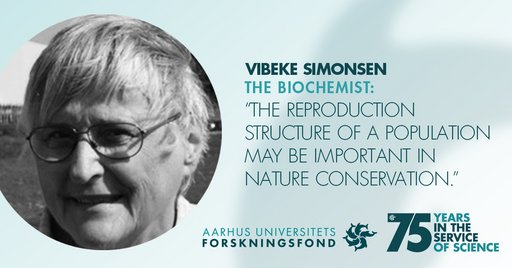
The Biochemist:
‘The Reproduction Structure of a Population May be Important in Nature Conservation’.
Associate Professor Emeritus Vibeke Simonsen worked with methods for the determination of paternity before DNA analyses became widespread.
My biggest Eureka moment was when I found that a parthenogenetic earthworm did not follow the Mendelian laws.
What led to my realisation was the considerable variation found in this earthworm species. Unfortunately, I did not have the opportunity to follow up on the result.
I felt deluded many times, hereunder in connection with the project that the Foundation supported. I had tried a method during a stay in the United States, where I found results that I could not repeat with the same organisms in Denmark. The electrophoretic analysis is about separating proteins in tissue or bodily fluid in an electric field, where the various proteins can then be detected by adding chemicals that are involved in a chemical reaction. The method allows you to change many different analysis parameters, so oftentimes you just had to use the trial and error method. After many futile attempts, I had to give up reproducing the concrete results.
I knew I wanted to work within research. After my graduation, I was given the opportunity to work at the then Department of Genetics at the Faculty of Natural Sciences, University of Aarhus, where I could utilise my knowledge of enzymes since, in my thesis, I had worked with enzymes. Unfortunately, I lacked knowledge of many zoological and botanical topics, but tried to learn about them along the way. The method of analysis that I used most often in my research career meant that I worked with many different organisms, so a constant updating of knowledge was necessary. I recognised early on that collaboration between people with different competences was a great strength.
My research is relevant to other people because it could be used in paternity cases before DNA analyses became common. Paternity cases can be used to investigate the reproduction structure of a population, but also between populations, which may be important in nature conservation.
I received support from the Foundation to purchase a scanner.
The support from the Foundation meant that I could incorporate another aspect of the electrophoretic variation in proteins, i.e. a relative quantification of the protein I was studying.
I am most proud of my work when I can convey it in a way that is understandable to laymen.
Right now, I am not studying anything as I retired in 2010.
BIOGRAPHY
Vibeke Simonsen
Former Associate Professor at the Department of Bioscience at Aarhus University.
MSc Biochemistry from the University of Copenhagen in 1967.
Support from the Research Foundation in 1981 to purchase equipment for the determination of unique alleles in amylase from drosophila pseudoobscura from Bogota (at the then Department of Genetics and Ecology).
Troels Fink
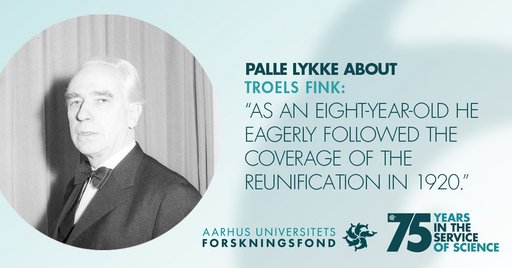
Palle Lykke about Troels Fink:
‘As an Eight-Year-Old He Eagerly Followed the Coverage of the Reunification in 1920’.
Historian Troels Fink (1912-1999) was extremely engaged in all matters concerning Southern Jutland – and helped to establish what later became the Danish School of Media and Journalism, says University Historian Palle Lykke, who interviewed Troels Fink in 1992.
His biggest Eureka moment was probably when, in the mid-1950s, based on his dedicated efforts at the Ministry of Foreign Affairs to draft the Copenhagen-Bonn declarations, he was able to declare himself ‘happy to have been involved in settling a contentious national issue’. The declarations determined that citizens on both sides of the border could freely profess to the Danish or German nationality and culture of their choice. The problems in the Danish/German border area had occupied him since, as an alert eight-year-old, he had eagerly followed the press coverage up to the Reunification in 1920. After all, Troels Fink was born in Aabenraa, which was then south of the Danish/German border.
What led to his work on the Copenhagen-Bonn declarations was, amongst others, his experience from the Southern Jutland Police Adjudantur, and that, on the basis of his dissertation on a Southern Jutland subject in 1941, he was employed in a newly established associate professorship in Southern Jutland history at Aarhus university. Later, he first became a senior associate professor and then a professor in the same subject, so the Ministry of Foreign Affairs could hardly have found someone better suited.
He must have felt most deluded … well, I hardly dare say it, but maybe it was in September 1933 when, after a few years of study at the University of Copenhagen, he wanted to try studying at the new Aarhus University. It turned out to be a disappointment, because it ‘was modest, what was going on’ so at the end of October, Fink found himself back in Copenhagen.
At that time, he could hardly have imagined that he would have a university career in Aarhus and even, in the 1940s, become a very active birthing coach for several satellites from Aarhus University. Among these were the Business Archive and the ‘Journalist Course at Aarhus University’, which later became the Danish School of Media and Journalism (now DMJX). He had hardly imagined that he would be the one to negotiate with Mrs. Ellen Dahl when, in the 1950s, she donated Sandbjerg Estate to the University.
He was hooked on his profession when, after a stay in Italy, he returned to Aabenraa and, even before he became a student, he was given the task of starting a registration of H.P. Hanssen's archive. His engagement was probably cemented when, during his study period at the University of Copenhagen, he attended and soon became the ‘chief’ of the sociohistorical study group work that took place at the Department of History and Socio-Economics.
His research is relevant to others, not least because it has increased the knowledge of the Southern Jutland circumstances over time and thus increased the opportunities to act appropriately in relation to various potential conflicts with our large neighbour to the south.
I think he was most proud of his work when, in 1946, he was appointed a consultant at the Ministry on Foreign Affairs on Schleswig issues. It was a recognition of his scientific production and insight into Southern Jutland matters, for which he was also rewarded in 1959, where he became Danish Consul General in Flensburg. That really gave him with the opportunity to deal with practical issues in the Southern Jutland area. That same year, he resigned from the professorship in Aarhus.
BIOGRAPHY
Troels Fink (1912-1999)
Professor of History at Aarhus University from 1950-1959 and from 1959-1975 Danish Consul General in Flensburg.
Master of Arts in History in 1936 and Doctor of Philosophy in 1941.
Support from the Aarhus University Research Foundation in 1948 for the purchase of an apparatus for reading of films.
Svend Hylleberg
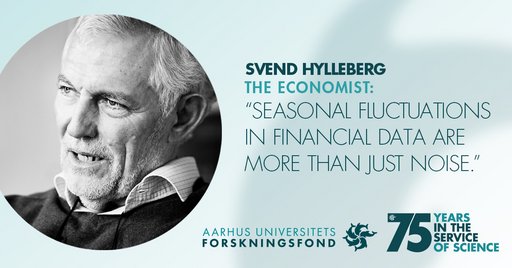
The Economist:
‘Seasonal Fluctuations in Financial Data are More than Just Noise’.
For decades, Professor Emeritus Svend Hylleberg has researched time-series economics and found that seasonal variations are due to more than just wind and weather.
My biggest Eureka moment I experienced several times. The first moment was in connection with the publication of my book ‘Seasonality in Regression’ at Academic Press in 1986, which was also my 1984 doctoral dissertation. It was a research project I had been working on for more than 10 years, which showed that seasonal variations in financial data were more than just noise. And the second moment was when, in the spring of 1987 in my office at UCSD, California, I discovered how to process and test for varying seasonal patterns in data, the so-called HEGY test.
What led to my realisation was years of studying not just the econometric techniques in the time-series area, but also the economic reason why the seasonal patterns change beyond what calendar, weather and wind would seem to indicate.
I felt most deluded when, in 1975, the famous Australian statistician Ted Hannan was not able to understand the difference between the asymptotic results and my simulation results, and I discovered that some of my results were due to programming errors. That lesson meant that I have always been extremely careful to guard against such mistakes.
I knew I wanted to work within my field when – after holding a critical seminar at the Department of Economics for all teachers in the spring of 1967 on Nicholas Kaldor's professor lecture in Cambridge ‘Causes of the slow rate of economic growth in the United Kingdom: an inaugural lecture‘ – I found out that I wanted to be a professor of economics.
My research is relevant to other people because it can be used in economic analysis, but also because it has given me an extensive international network which has been useful to my many students and colleagues and thus has been an important basis for the high status of the Department of Economics within time-series economics.
I received support from the Foundation for my many stays at the Department of Economics, UCSD, La Jolla, California, which was an important meeting place for many international researchers within time-series economics.
The support from the Foundation meant that I was able to maintain and develop the working community I had with these researchers.
I am most proud of my work when some of the many students I have helped to train come up with valuable new research results or otherwise show that the master of economics or mathematics-economics degree and the subsequent PhD degree at Aarhus University are second to none.
Right now, I am researching the economics study programme and the history of the Department of Economics from its establishment in 1936 until 1966.
BIOGRAPHY
Svend Hylleberg
Professor Emeritus at the Department of Economics, Aarhus BSS, Aarhus University.
Dean of the School of Business and Social Sciences, Aarhus University. 2011-2015.
Dean of the Faculty of Social Sciences, Aarhus University. 2006-2011.
Head of department, Department of Economics and Business Economics, Aarhus University. 1998-2006.
Master of Economics 1971 and Doctor of Economics 1984.
Support from the Aarhus University Research Foundation in 1982 for non-scientific assistance and travel and accommodation expenses in connection with the project ‘Seasonal variation in regression data’.
Signe Normand
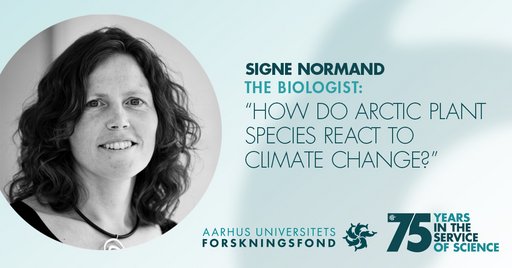
The Biologist:
‘How Do Arctic Plant Species React to Climate Change?’
Professor Signe Normand is researching the response of plant species to climate change – by means of, amongst others, satellites and drones.
My biggest Eureka moment was when I found that about half of Europe's plant species since the last ice age have not spread to all the locations where the climate is suitable for them. In spite of the thousands of years available to them, they have not been able to fully respond to the warming trends of our current global warming period. This recognition is important because it contributes to our understanding of the extent to which different species can respond to the ongoing climate change.
What led to my realisation were models of how climate restricted the spread of more than 1,000 plant species during the last ice age and the extent to which the current distribution of the species is still limited to these areas.
I felt most deluded when doggedly trying to elucidate the fundamental hypothesis that plant species are generally more limited by climate at their northern than their southern geographic boundary, where interactions with other species are expected to play a greater role. I was convinced that the nature of the responses by the species could contribute with important understanding. In the end, it turned out to be true, but the quantification of the responses by the species and their significance led me to pursue many wrong tracks.
I knew for sure that I wanted to work with biology when, after a folk school stay with focus on outdoor life and sustainability, I abandoned the idea of studying physics. Since I was a child, I have had a great fascination with nature. In elementary school, biology was my favourite subject, and I attended a biology continuation school. So maybe it has always been my destiny.
My research is relevant to other people because it provides insight into the ways in which Earth's diversity of species responds as climate change and thus also insight into the possible consequences of the climate change. I study the prehistoric, present and potential future spread of species. In recent years, I have especially contributed to an understanding of how Arctic plant species respond to the ongoing climate change.
I received support from the Foundation in 2011 when I received the Aarhus University Research Foundation’s PhD Award, and again in 2016 when I received the Foundation’s Starting Grant to build a research team focusing on the use of drones when trying to understand responses by species across both time and space.
The support from the Foundation meant that I could set up an independent research team and a lab with focus on the use of drones to answer questions within ecology.
I am most proud of my work when the research results manage to fascinate ordinary people and increase their understanding of Earth's diversity and the complexity of the ongoing changes.
Right now, I am studying the importance of microclimate for decades of variation in the growth of Arctic bushes in Greenland, and how different types of data from drones and satellites can be used to map and understand the rapid changes in biodiversity.
BIOGRAPHY
Signe Normand
Professor of Vegetation Dynamics at the Department of Biology at Aarhus University.
Biologist in 2006 and PhD in Biology 2010.
Support from the Aarhus University Research Foundation in 2011 in the form of the PhD Award and in 2016 to start her own research group.
[l1]Betyder det, at den nuværende varmetid har varet i tusindvis af år?
P.G. Lindhardt

Carsten Bach-Nielsen on P.G. Lindhardt:
‘For Inner Mission, Lindhardt was the incarnation of “The Den of Thieves” – The Faculty of Theology.’
P. G. Lindhardt (1910-1988) made history as the one who ‘abolished eternal life’. This happened at a lecture at Askov Folk School, where, as a critical historian, he uttered the words that no one could claim an extension of life on earth into eternity, says Carsten Bach-Nielsen, Associate Professor of Church History at Aarhus University.
His biggest Eureka moment was probably the ‘discovery’ of Morten Pontoppidan, Henrik Pontoppidan's brother, around 1950. Morten Pontoppidan was a follower of Grundtvig, pastor, folk school teacher, writer and debater – and placed on the extreme, liberal wing of his church and cultural life. He was enthusiastic about the young Germany in the early 1800s, about the modern breakthrough and thus not particularly national. Pontoppidan himself was part of a spiritual awakening – and those people Lindhardt did not care for – but at the same time, he broke with the exclusivity of the awakenings.
The work that led to this recognition was obviously the work on his dissertation in the 1930s on the Danish-Norwegian pietism – but from a different angle. Lindhardt saw pietism as an awakening, but also as an exclusive association of orthodox and believers. This made the church exclusive and closed land for ordinary people. Lindhardt's childhood environment was heavily influenced by novel pietism, but he found it difficult to see a way out of its grip.
He must have felt most deluded when he was looking for ways to finally break away from pietism through the study of the enlightenment literature. He discovered that the enlightenment was both pious and elitist. He was in search of a voice and a personality in the contemporary world that had fully engaged in the fight against the constraining awakening understanding. The closest he came was probably Kierkegaard's church criticism from the 1850s, but the meeting with Pontoppidan redeemed him.
He was hooked on his subject already as a high school student in Odense, where his brother-in-law L.P. Fabricius was a pastor and church historian – and later at the University under Professor J. Oskar Andersen. During World War II, he developed a close relationship with the modern bishop of Aarhus, Skat Hoffmeyer, who used a direct and modern-day language in his dissemination. Lindhardt used his church history in his sermons which he held in ‘Vor Frue Kirke’ (Church of Our Lady). They became a kind of cultural attraction because they were also ‘enlightening’.
His research is relevant to other people because he freed an entire generation from the pressure that lay on it. Many students came from awakening environments where the boundaries and discipline were clear. After all, one had to advance God's will during life on earth, living up to the expectations of one’s home and not least the group. Lindhardt worked as a materialistic historian under the influence of Hans Kirk. He saw the awakenings as something man himself had constructed – not a framework for God's demands on the individual. Many felt that they were set free from their environments by Lindhardt's new research.
He received support from the Foundation to study the breakthrough of the enlightenment literature. It turned out to be a partially unsuccessful project which nevertheless led him to more central issues. It was the awakening research that made Lindhardt known throughout the Nordic countries.
I think he was most proud of his work when he could see the bridge between the work of the historian and the pastor. His psychological insight was sharpened through the historical figures of the 19th and 20th centuries whom he wrote about. His understanding of Christianity, in turn, cast an extenuating look on most of those he basically did not agree with. I do not believe that Lindhardt ever showed pride in the usual sense. Probably, a bit of pietism was hidden in him after all: an attentiveness for the private space.
BIOGRAPHY
Poul Georg Lindhardt (1910-1988)
Professor of Church History at Aarhus University and Assistant Pastor at ‘Vor Frue Kirke’ in Aarhus.
Master of Theology in 1934 and Doctor of Theology in 1938, both from the University of Copenhagen.
Support from the Aarhus University Research Foundation in 1946 for a ‘major work on the dissemination and influence of Danish enlightenment literature’.
Peter Skautrup
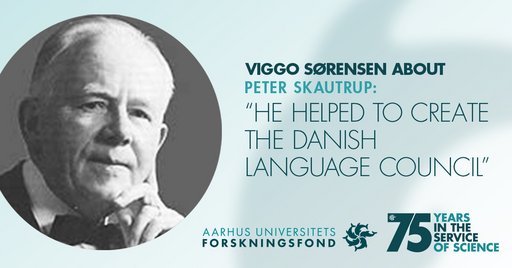
Viggo Sørensen about Peter Skautrup:
‘He helped create the Danish Language Council.’
Language Professor and former Rector Peter Skautrup (1896-1982) was an entrepreneur. He participated when Aarhus University was established in 1928, and four years later he established the Department of Jysk Language and Cultural Research, says Viggo Sørensen, Editor of Jysk Dictionary and Head of the Peter Skautrup Center for Jysk Dialect Research at Aarhus University.
His biggest Eureka moment must have been when, during his work on Danish Language History, Volume I, in the middle of World War II, he realised a number of phonetic contexts in the development of Danish (based on Old Norse) and ‘Jysk’ (the language of Jutland and based on Old Danish). His discovery is briefly outlined in the article ‘Contexts in Dialectical Development’ which can be read in Danish Language and Culture from 1976. The theory is still generally valid.
The work that made Peter Skautrup nationally known was the very same Danish Language History I-IV, which was published between 1944 and 1968. Unlike earlier language historians, Peter Skautrup saw the development of the language as a reflection of historical social development. And he was able to convey the subject matter in a common language that the man in the street could understand – except for specially marked sections with academic documentation in support of the arguments.
He must have felt deluded when, in the first volume of the journal ‘Language and Culture’ from 1932, he ventured into an interpretation of the inscription on the runic stones found in 1927 from the small village of Vinterslev, which today is a quarter of the town of Hadsten. However, the stones soon turned out to be fake, a simple children’s prank. No matter how much it must have upset Peter Skautrup, he honestly and publicly regretted his mistake.
His research is still relevant to the Danes, especially as it was published in Danish Language History, and primarily by virtue of Peter Skautrup's sociolinguistic approach and simple linguistic dissemination. Only now, there is a worthy replacement under publication, i.e. the Society for Danish Language and Literature's Danish Language History in six volumes – this time written by a whole team of linguists.
He received support from the Foundation for Jysk Language and Cultural Research in 1978, for the printing costs.
It is difficult to say when he was most proud of his work – the age gap between us taken into account. It might have been when he was editor of the Dictionary of the Danish Language and in 1926 was awarded the University of Copenhagen's gold medal for a ground-breaking analysis of the vocabulary of his childhood dialect. But very likely he was also proud when he helped create the Danish Language Council, for which he became the first chairman from 1955 to 1961.
Jens Peter Andreas Skautrup (1896-1982)
Professor of Nordic Languages at the University of Aarhus 1934–66, Head of the Department of Jysk Language and Cultural Research 1932-1966 and the University's Rector 1953–55.
Master of Arts in Danish, History and English in 1922.
Support from the Aarhus University Research Foundation in 1978 for printing costs in connection with activities at the Department of Jysk Language and Cultural Research.
Malene Bek-Thomsen

The molecular biologist:
‘Despite their small size, they have an incredible number of deaths on their conscience.’
Molecular Biologist Malene Bek-Thomsen studies the potential of new technologies when it comes to faster diagnosis of patients.
My biggest Eureka moment was the realisation that the world of microbiology is a wonderful world – full of microscopic characters that we live in close symbiosis with and in no way can be without. At the same time, despite their small size, some of them have an incredible number of deaths on their conscience. At one and the same time, the small characters are admired and hated.
What led to my realisation were skilled and dedicated teachers and numerous hours in the company of scientific books and articles.
I felt most deluded when, after countless long days and late hours in the office, I had to realise that some of my research results could not be reproduced and therefore not published.
I knew I wanted to work within microbiology when, in connection with my dissertation, I became associated with Mogens Kilian's research group at the former Department of Medical Microbiology and Immunology (now Biomedicine). As a supervisor, Mogens Kilian was infectious in his commitment, his knowledge and his great interest in bacteriology.
My research is relevant to other people because it seeks to improve the diagnostic capabilities and thus is of direct benefit to patients.
I received support from the Foundation for an eight-month stay abroad at The Pathogen Functional Genomics Resource Center, J. Craig Venter Institute, Maryland, USA, in connection with my PhD study. At that time, the Institute in the United States was a leader in advanced molecular technology which I was able to utilise to uncover some of my scientific questions.
The support from the Foundation meant that the stay in the United States could be realised and I could bring my husband and then one-year-old daughter.
I am most proud of my work when it makes a difference and benefits others. My current work is directly applicable for the benefit of patients which I find very satisfying.
Right now, I am studying the potential diagnostic applications of new technologies and working to implement better and much faster diagnostic methods for the benefit of patients.
BIOGRAPHY
Malene Bek-Thomsen
MSc Biology in 2006 and PhD in Microbiology 2012.
Molecular Biologist at the Department of Clinical Microbiology, Lillebaelt Hospital. Former postdoc at the University of Aarhus.
Support from the Aarhus University Research Foundation in 2010 for a stay at the J. Craig Venter Institute.
Lise Togeby
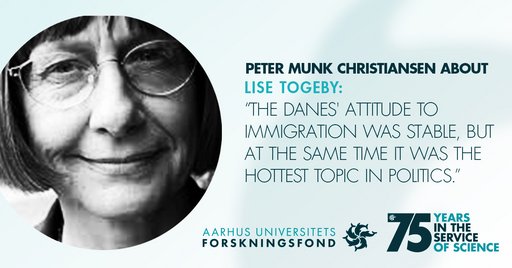
Peter Munk Christiansen about Lise Togeby:
‘The Danes' attitude to immigration was stable, but at the same time it was the hottest topic in politics.’
Political Science Professor Lise Togeby (1942-2008) found that although a large electoral group moved toward immigrant-critical parties in the 1990s, the attitude of average Danes did not change. These are the words of Peter Munk Christiansen, Professor and Head of the Department of Political Science.
Her biggest Eureka moment was maybe when she realised that the internationally established scientific truth that women vote like their husbands does not hold true for women who work outside the home. When women gain employment, their jobs become a better indicator of their vote than their husbands' voting behaviour.
The research that led to her realisation was the detailed and thorough empirical work that characterised her entire career. What is behind these fluctuations? What kind of pattern do they fit into? When reality behaves differently than suggested by theory, it is not reality that is the problem. It is the theory.
She felt challenged when, around the turn of the millennium, she struggled to understand how the Danes' attitude to immigration could be stable over a 30-year period when, at the end of the 1990s, the question turned into the hottest topic in Danish politics and caused large groups of voters to move toward immigrant-critical parties. She showed that even deep-rooted attitudes can fluctuate around a fairly unchanged average.
She was hooked on her subject when – already before her graduation – she answered a prize paper on the Social Democratic Party’s idea policy, arranged by the University of Copenhagen's Philosophy Faculty, and was awarded a gold medal. The paper – later published in a heavily abbreviated version under the title Were they actually that red? – showed that it was practical issues that had dominated the early idea development in the Social Democratic Party. The party was not particularly ideological, nor particularly red.
Her research is relevant to other people because in the fields of research which she addressed during her research career – young people's political choices, women's political participation, refugees and immigrants' integration into Danish society, formation of political attitudes – she managed to dig into the matter in a way that allowed her to provide qualified answers as to how key issues in these areas could be handled.
I think she was most proud of her work when she presented the ‘Magtudredningen’ (the Danish Democracy and Power Study), even though she did not like that kind of show with herself at the centre. The public had mixed reactions to the final report of the study, and some accused her of political compliance. Nothing was more remote for Lise; on the contrary, she was proud that the study on ’Magtudredningen’ had such a strong academic foundation that it was translated into no less than 49 books and 35 smaller publications.
BIOGRAPHY
Lise Togeby (1942-2008)
Professor of Political Sociology at the Department of Political Science, the University of Aarhus, where, during her research career, she also served as head of department and head of studies. She was the head of the Danish Parliament’s Democracy and Power Study ‘Magtudredningen’ 1997-2003.
MSc Political Sciences in 1966 and Doctor Political Sciences in 1994.
Support from the Aarhus University Research Foundation in 1979 for scientific assistance.
Lauritz B. Holm-Nielsen
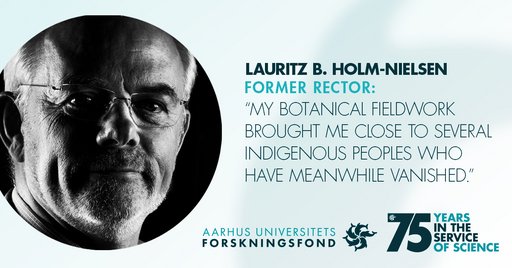
Former rector:
‘My botanical fieldwork brought me close to several indigenous peoples who have meanwhile vanished.’
As a young man, biologist and former Rector Lauritz B. Holm-Nielsen dreamed of exploring South America and, in the late 1960s, he started a pioneering work to collect 100,000 plant specimens which today makes up one of Aarhus University's unique collections
There have been several moments when the feeling of understanding things in a larger context has been present. Before I started studying at the University of Aarhus, I experienced some of the last indigenous inhabitants of Tierra Del Fuego, a people who at the time was only found in that specific location and who has long since become extinct. It occurred to me that our way of life is so overwhelming that other cultures and peoples simply disappear. Anthropology is not my field of research, but my botanical fieldwork in South America brought me close to several indigenous peoples who have now vanished.
In 1968 I was sitting at the top of a volcano near Chimborazo in the middle of the Andes, where, in 1801, Alexander von Humboldt observed the climatic and botanical altitude zones. Here, I had my biggest Eureka moment, here, the general context in the natural ecosystems seemed clear to me. This was before I became aware of Humboldt's great thesis: that human activity forever changes the context of nature. I intuitively got the same understanding that we, mankind, are now so plentiful and our technologies so powerful that they enable us to transform the evolution of earth in an irreversible process. It is clear that nature is under pressure everywhere.
I have most definitely been curious and followed many different tracks, but I do not really think I have ever felt deluded. Certainly, some of the tracks did not lead to scientific breakthroughs, but they have all contributed with experiences that have proved useful in other contexts.
Already as a young man, I dreamed of exploring the tropics, preferably in South America, both because the indigenous people there fascinated me, and because the complexity of the tropical rainforest attracts a biologist. I wanted to get to know the amazing plant species and gather scientific collections as evidence of what is now known as biodiversity.
My own research into botanical taxonomy, especially with respect to passion flowers and tropical aquatic plants, has no economic significance. Conversely, knowledge of the species and their biology is a prerequisite for the very important studies of tropical ecosystems. Therefore, the thousands of well-documented botanical collections located in Aarhus University's herbarium and in some of the world's most important scientific collections are invaluable for both biodiversity and climate research.
In 1981, I received DKK 60,000 from the Research Foundation for PROSE salaries, etc., when I returned to Aarhus University with a very large plant collection after serving as a professor at Pontificia Universidad Catolica in Ecuador. It may sound a bit boring, but when you are standing with handwritten field notes and about 100,000 plant specimens distributed on more than 20,000 individual collections from hundreds of different locations, it is a lot of work to record and write labels, make databases, etc. We had no laptops back then and the computer programmes were primitive, so there was a real need for processing of data and plant collections from extensive fieldwork in Ecuador, which is one of the most species-rich areas in the world.
The support from the Foundation meant that we were able to process the extensive material which was crucial in order for the material to be made available to other researchers around the world. It is now part of the university's unique scientific collections. It is very satisfying to know that the many Danish and foreign scientists working with the plant world in the Andean mountains and the Amazon ecosystems can use our collections and records in their research. The pioneering work that I contributed to has since given many, not least Ecuadorian students and researchers the opportunity to understand the nature of their own country.
I have not been active within research since 1986, where I started working with university and research management. But I have often reminded economists and lawyers, not least in my work for the World Bank, that no one knows the jungle law better than a tropical botanist! I have been able to extensively utilise my experience from the research into the tropics’ ecosystems. Humboldt’s understanding of the context in nature is universal, and it is certainly knowledge I will also use as the first chairman of the Danish Nature Fund. The Fund's priority is buying space for the Danish nature, thereby giving natural biodiversity a better chance.
BIOGRAPHY
Lauritz B. Holm-Nielsen
Chairman of the Danish Nature Fund. Rector of Aarhus University 2005-2013 and Dean of the Faculty of Science 1976-1979. In addition, advisor to the World Bank on higher education, research and innovation 1993-2005.
Master of Science Biology in 1971.
Support from the Aarhus University Research Foundation in 1981 for PROSE salaries to the Botanical Department for processing data and plant material from the Ecuador project.
Henrik Kaare Nielsen

The cultural researcher:
‘Even a well-consolidated democracy as the Danish is a fragile thing.’
Professor Henrik Kaare Nielsen's research into contemporary culture helps to make the obvious less obvious, so that we can all relate more critically to it.
My biggest Eureka moment was the realisation that even a – in a historical context – exceedingly well-consolidated democratic political culture such as the Danish is fragile and constantly requires a high degree of mutual commitment and the will to compromise on the part of all players.
What led to my realisation was the comparative analysis of political culture and new social movements in West Germany and Denmark that formed the basis for my dissertation. Despite major principle and historically determined differences, it turned out that there were relatively parallel practical experiences in the two countries. Thus, at crucial times during the 1960s, 70s, and 80s, it was almost a coincidence that the development in Denmark did not escalate to left-wing terrorism and tendencies toward an authoritarian security state like in West Germany.
I felt most deluded at the time, in 1989, when the Berlin Wall suddenly collapsed and ushered in the dissolution of the entire Soviet Empire. Not that I had any sympathies or hopes associated with the Eastern Bloc and its political system, but throughout my research career, it had represented a well-established geo- and power political fact which all political and cultural contemporary analyses to some extent had to take stock of, and which helped define the overall horizon one was thinking within. The need to reorient yourself was therefore urgent in 1989.
I knew I wanted to work with cultural analysis when two of my teachers and supervisors at the master’s degree programme showed great interest in my work, engaged me in collegiate discussions and encouraged me to take the research path. Many thanks to Karsten Hvidtfelt Nielsen and Jørgen Kjær at the then German Institute.
My research is relevant to other people because it addresses issues that are central to contemporary social life, including the everyday life of the individual citizen. By way of theoretical and historical perspectives, the research contributes to make the obvious less obvious. The contemporary culture thus becomes something that can be critically reflected upon, and it becomes clear that the everyday practice of the private citizen contributes to creating, recreating and changing it.
I received support from the Foundation partly for the publishing of a number of books and partly for an AU IDEAS Pilot Center (2012-2016), where I was the head of an interdisciplinary research group with members from both the humanities and the social sciences. The Center worked with the current challenges and development perspectives of the general democratic public.
The support from the Foundation meant that the publishers were financially able to commit to publishing my relatively narrow textbook manuscripts, and that a valuable interdisciplinary research collaboration could be realised. A big thank you for that.
I am most proud of my work when it helps other people to understand the cultural and societal relationships of which they are part and inspire them to think further on their own.
Right now, I am exploring aesthetic experience formation and its potentials and limitations in a democratic public perspective. In this connection, I study, amongst others, the strong contemporary populist tendencies.
Henrik Kaare Nielsen
Professor of Cultural Theory and Cultural Analysis at the School of Communication and Culture at Aarhus University.
Master of Arts in 1979, Lic.Phil./PhD in 1984 and Doctor of Philosophy in 1991.
Support from the Aarhus University Research Foundation several times for, amongst others, printing costs and the AU IDEAS Pilot Center.
Hakon Lund
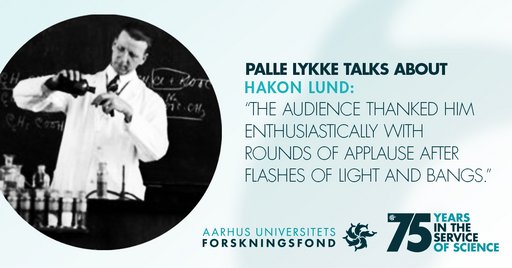
Palle Lykke talks about Hakon Lund:
‘The audience thanked him enthusiastically with rounds of applause after flashes of light and bangs.’
Chemistry Professor and Rector Hakon Lund (1898-1979) liked to disseminate his complicated subject so everyone understood it, including at public evening lectures at the University in the 1930s, says University Historian Palle Lykke.
As a chemist, Hakon Lund probably had several Eureka moments, but one of his first major ones may well have been in the mid-1920s, when he was working on his dissertation, where his work made a ‘significant experimental contribution to the perception of the structure of triphenylcarbenium ions’, as one of his colleagues put it.
On the whole, he was a great experimenter every day and also liked to disseminate and popularise. In the 1930s, he was the person behind the most popular of the evening lectures at the University of Aarhus, which were open to the public, and where, for full houses, he demonstrated the making of ammonia from the nitrogen and hydrogen of the air, and where, after the demonstration's flashes of light and bangs, the thrilled audience thanked him with rounds of applause. The radio listeners also had pleasure of broadcast lectures, where he performed with so-called ‘bubbly air’.
The work that led to his realisation of the structure of triphenylcarbenium ions in the dissertation was that he had previously been on an inspirational study trip where he met the discoverer of the triphenylmethyl radical, Professor Moses Gomberg, at the University of Michigan.
He must have felt most deluded when an expurgation committee established by the Teachers' Assembly during the occupation subjected his deeds to investigation on the basis that he had been a member of the Danish-German Association. However, nothing was found. During the occupation, he had a brief stint as Rector of Aarhus University from 1940 to 1941 and was quite popular with both colleagues and students. For the big annual dormitory parties held in the lobby, it was a fixed ritual that the partygoers at some time would shout ‘Hakon! Hakon! Hakon’! after which the professor would stand on his head on the table, drinking an aquavit at the same time.
He was probably hooked on his profession when he discovered he had a mighty talent for finding shortcuts in complicated chemical syntheses or finding new roads to well-known goals.
His research is relevant to other people because it could and still can be widely used in the industry. In this connection, he obtained a number of posts associated with the Danish chemical industries after the war and also joined the gas commissions of both the Army and the Ministry of the Interior. For example, in his research he undertook to synthesise various nerve gases with the aim of thoroughly understanding them so that in case of gas attacks, the most appropriate measures could be taken.
I believe that he was most proud of his work when, for the second time, he helped to design the layout of a new chemical department at Aarhus University. The first time was in 1933, the second time was in 1961, when the current chemical complex was inaugurated.
BIOGRAPHY
Hakon Lund (1898-1979)
Professor of Chemistry at the University of Aarhus from 1933-1968 and Rector of the University 1940-41.
Master of Arts in Chemistry in 1922 and Doctor of Philosophy in 1926.
Support from Aarhus University Research Foundation in 1951 for a study trip to the USA.
Franz Blatt
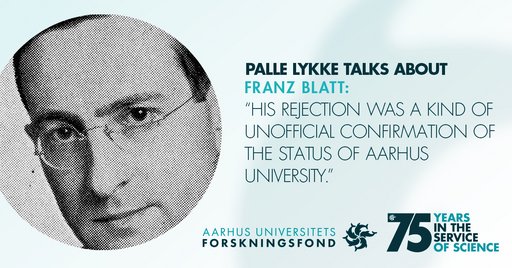
Palle Lykke talks about Franz Blatt:
‘His rejection was a kind of unofficial confirmation of the status of Aarhus University’
In 1930, former Rector and Professor Franz Blatt (1903-1979) brought classical philology to the University Studies in Jutland and since then, he several times refused to return to Copenhagen, says University Historian Palle Lykke.
His biggest Eureka moment was probably when, in the late 1920s, he discovered that there existed not just one, but two different editions of an early medieval Latin translation of a colourful Greek hagiographical writing, i.e. the account of the Apostles Mathias' and Andreas' adventures among cannibals. This finding led him to produce a scientific compilation of the two translations and the work culminated in the dissertation which he defended at the University of Copenhagen in 1930. It qualified him for the position as Docent which he took up at the University Studies in Jutland, as Aarhus University was initially called.
The work leading to his realisation took place, among other things, during a stay in Lund in 1925, where he studied with Professor Einar Löfstedt. It was he who had drawn young Blatt's attention to the translation which was already known, and where Blatt later found that another translation also existed.
He must have felt most deluded when he worked as a teacher at various Copenhagen schools and courses in the years 1926-1928 because, undoubtedly, it was science that appealed to him. Already in 1928, he was given the opportunity to work scientifically, i.e. when – with support from the Carlsberg Foundation – he was able to go to Munich and work at the editorial office of Thesaurus Lingua Latinae, the great international dictionary of ancient Latin. Incidentally, a large part of his later research career in Aarhus was also editorial by nature and, not least, within the Medieval Latin area.
He was hooked on his subject when he attended the Metropolitan School in Copenhagen, where J.L. Heiberg – Professor of Classical Philology – was teaching Latin. He became so excited that he plunged himself into the subject after his 1921 high school graduation.
It is said that when he decided to apply for the position as a Docent at the University Studies in Jutland – in spite of calls to remain in Copenhagen – it was due to an urge to make use of the great practical-constructive skills he possessed which could not fully unfold in a subordinate position at the University of Copenhagen. Indeed, much of his research resulted in dictionary and publishing projects, including the Diplomatarium Danicum and parts of the Letters of the Kingdom of Denmark.
He received support from the Foundation in 1946 for study trips in Paris to compile a unified representation of medieval Latin.
I think he was most proud of his work when his scientific reputation in 1940 brought an invitation from the University of Copenhagen. He was one of the few people at the time to reject such an invitation, and he was hailed by his colleagues who celebrated him and by his students who arranged a procession with flags in his honour. Somehow, his rejection was kind of an unofficial confirmation that the status of Aarhus University was equal to the old university in the capital.
BIOGRAPHY
Franz Blatt (1903-1979)
Professor of Classical Philology at the University of Aarhus 1934-1972 and the University's Rector 1949-1951.
Master of Classical Philology in 1926 and Doctor of Philosophy in 1930.
Support from the Aarhus University Research Foundation in 1946 for a study trip to Paris with a comprehensive production of the Medieval Latin in mind.
Annie Vesterby Charles
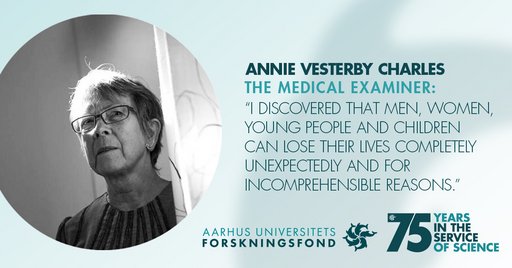
The medical examiner:
‘I discovered that men, women, young people and children can lose their lives completely unexpectedly and for incomprehensible reasons.’
Professor Emeritus Annie Vesterby Charles has conducted research into the bones of human beings, which is essential for medical examiners when identifying deceased people or uncovering the causes of death.
The Eureka moment that mattered the most to me in my career occurred as a newly graduated doctor and working at the Department of Forensic Medicine in 1975. Here, I discovered that men, women, young people and children can lose their lives completely unexpectedly and for incomprehensible reasons, often after tragic events such as accidents, suicides and homicides or for natural, but unexplainable reasons.
I also learned that some children and young people are subjected to abuse and neglect by the adults who should have taken care of them and protected them. I saw that more knowledge and research was needed to uncover and prevent unexpected deaths, violence, abuse and neglect and, when it did still occur, to help those affected to go on in life in a caring and professional way. I decided that I would be permanently employed at the Department of Forensic Medicine and the career choices I subsequently made were borne by this desire.
The Eureka moment of significance for the part of my research that led to my dissertation in 1995 came later, when I was a clinical assistant at the Department of Pathology in Aarhus, associated with the ‘bone group’ under the late Professor Flemming Melsen. Knowledge of the human skeleton and bone structure is important knowledge for the medical examiner, partly for identification and when finding bones, and partly for understanding the skeleton's response to, for example, trauma, intake of various stimulants and substance abuse. Professor of Stereology Hans Jørgen Gundersen made me realise that using stereological principles on histological 2D incisions would give me valid, unbiased estimates of the 3D structure of bone tissue – and that they could thus replace the biased morphometric estimates used so far.
What led to my realisation was the nature of the work at the Department of Forensic Medicine and the inspiring working environment with a constant and in-depth inquisitive approach to the solution of the tasks, often in collaboration with other professional groups. A realisation that was strengthened when attending scientific congresses and visiting foreign forensic institutes, especially in the United States.
I do not remember feeling deluded. Already as a newly graduated doctor employed in the Department of Forensic Medicine, I was fascinated by the research and wrote a prize paper on the examination of the cardiac conduction system at sudden unexpected death. In 1977, the paper was awarded a gold medal.
In connection with my dissertation, however, I suddenly felt unsure whether the new stereological measurement methods I introduced into bone research would manage to gain a foothold in the research community, which had already adopted the commonly used, but biased morphometric methods as the true measurement methods.
I knew I wanted to work within my profession when I was hooked on the profession already as a newly graduated and employed doctor, and it became a passion that has not yet left me.
My research is relevant to other people because it helps answer important questions about the cause of someone's death – and not just to the individual person or the close relatives, but also to the police investigation, the justice system and society as a whole in order to prevent premature death, violence, accidents and neglect.
I received support from the Research Foundation for my bone research and children’s study etc.
The support from the Foundation meant that the special technical knowledge that was developed in connection with my dissertation work on bone structures could be retained at the Department of Forensic Medicine and later led to the establishment of a still well-functioning and unique bone laboratory. As far as I know, this is still the only one of its kind at a forensic department. The support for the children’s study made it possible to purchase the necessary equipment to carry out special examinations of children exposed to sexual abuse in a caring way, and this increased the focus on child abuse.
I am most proud of my work when I see the profession evolve as new knowledge is created through research and when this knowledge is disseminated to the surrounding community, and when it helps to prevent premature death and the abuse of children and young people.
Right now, I am investigating – as a member of a steering committee – how GPs are best ‘equipped’ to spot children and young people who may be or have been abused.
BIOGRAPHY
Annie Vesterby Charles
Professor Emeritus at the Department of Forensic Medicine at Aarhus University.
Medical Doctor in 1975 and Doctor of Medical Sciences in 1995.
Support from Aarhus University Research Foundation several times in the 1990s and later, among other things to study changes in bone structures and the development of improved examination techniques in clinical forensic medicine for children.
Anders Vinding Kruse
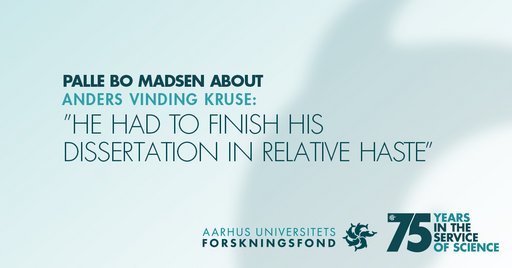
Palle Bo Madsen about Anders Vinding Kruse:
‘He had to finish his dissertation in relative haste.’
Anders Vinding Kruse (1921-1995) was Denmark's youngest law professor and, among other things, heavily involved in the Nordic cooperation within the justice sector, says Professor at the Department of Law at Aarhus University, Palle Bo Madsen.
The work leading up to Anders Vinding Kruse's dissertation and later university career began with a study trip to England and a brief period as an assistant lawyer, but from 1951 until 1991, when he left his professorship as a 70-year-old, he was a man of the university. Thus, in a review of his dissertation from 1950, the Swedish Law Professor Hjalmar Karlgren wrote in the Swedish journal ‘Svensk Juristtidning’: ‘This extensive work is of particular interest and shows that its author has great scientific imagination and ability. Considering that it is his first work, it represents a significant achievement’.
He had to finish his dissertation in relative haste when two law professorships were posted at the University of Copenhagen, one of which had become vacant after his father. He applied for it, but did not get it. Instead, he applied for and obtained a professorship at Aarhus University in 1951 – as Denmark's youngest law professor.
According to Aarhus University's Annual Report 1950-51, the Professor Assessment Committee found that he had ‘not yet matured sufficiently with respect to methodical clarity’, but given his young age, the Committee emphasised the good sides of the dissertation and that he was expected to be able to make significant research contributions within Danish law of obligations. Which he did indeed.
He was well-respected among the law students in Aarhus. When he left Aarhus University in 1955 in favour of a similar professorship at the University of Copenhagen, the students did – according to Jens Evald's 2005 biography of his father Frederik Vinding Kruse – send him a letter urging him not to apply for the professorship in Copenhagen, but in vain.
His interest in his subject was probably almost innate. As son of the then very renowned Law Professor Frederik Vinding Kruse, it was probably predestined that he would follow in his father's footsteps.
His research was primarily within the legal field of obligations and personal injury and resulted in several well-written legal works and textbooks as well as a large number of articles. As a very young law student at the University of Copenhagen in the early 1970s, I myself had the pleasure of having him as a lecturer in the subject ‘sale of goods’.
He was strongly engaged in the Nordic cooperation within the justice system and was, among other things, a member of the board of the Nordic Lawyers’ Meetings, where, since 1872, a large number of lawyers from all the Nordic countries had met every three years in one of the Nordic capitals to tend to and carry on the Nordic cooperation within the justice sector.
Outside of the university world, he put a lot of work into legislature preparation commissions and committees and, among other things, he contributed to the drafting of new legislation within his disciplines.
I think he was most proud of his work when, as early as 1950 – three years after graduating – he defended his dissertation entitled ‘Restitutions. A contribution to the study of the enrichment principle in Danish and foreign law’. Or maybe when in 1971, when he became an honorary doctor at the University of Iceland.
BIOGRAPHY
Anders Vinding Kruse (1921-1995)
Professor of Jurisprudence (law of obligations) at the University of Aarhus 1951-1955 and at the University of Copenhagen 1955-1991.
Master of Laws in 1947 from the University of Copenhagen and Doctor of Laws in 1950.
Support from the Aarhus University Research Foundation in 1952 for the preparation of a presentation on the legal aspects of purchasing real estate as related to the law of ob
Vibeke Hjortdal
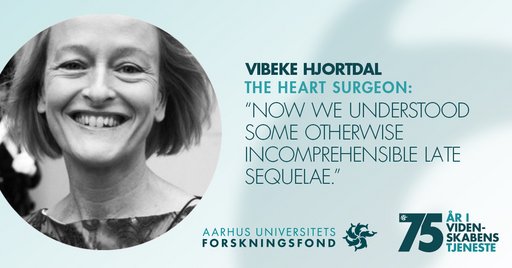
The heart surgeon:
‘Now we understood some otherwise incomprehensible late sequelae.’
Professor Vibeke Hjortdal operates on children with congenital heart defects and has helped to develop a new surgical method that gives fewer late sequelae for those operated on.
My biggest Eureka moment was when I managed to establish translational research concerning human lymphatic vessels. It was a collaboration between Donna Bødtkjer from Biomedicine at the University of Aarhus and Niklas Telinius, Aarhus University Hospital, with inspiration from the Great Ormond Street Hospital in London and some of the heart children I have operated on over the years. They live with a circulation that affects the drainage from the lymphatic vessels back into the body's veins. We could see that human lymphatic vessels spontaneously contract with an impressive force, but that they are adversely affected by a special operation we perform for certain congenital heart diseases. The effect on the lymphatic vessels leads to some of the late sequelae that heart children experience many years after the operation. This has subsequently led to the development of a new surgical procedure where the lymphatic vessels are less affected.
What led to my realisation was a collaboration between disciplines, specialties and departments. New insights meant a paradigm shift in our understanding of the functions of the lymphatic circulation in connection with congenital heart diseases. Now we could link knowledge of congenital heart diseases with knowledge of how blood vessels behave and then apply it to the lymphatic vessels. It meant that we now understood some otherwise incomprehensible late sequelae.
I felt most deluded at the time when several of my foreign colleagues from major centres thought I was completely out of line.
I knew I wanted to work in my profession when I started operating on heart children and discovered a number of unresolved issues that were of great importance to them and the life they had to look forward to.
My research is relevant to other people because it constantly answers questions I encounter in my clinical work as a doctor for children and adolescents with congenital heart diseases. When I operate on a heart child, it makes life better for the individual child and the individual family. When I conduct research into congenital heart diseases, it may have consequences for everyone born with that heart defect.
I received support from the Foundation very early in my career as a PhD student for a study of microcirculation in tissue transplants.
The support from the Foundation meant that I was able to clarify how blood clots can build up and dissolve in a blood vessel, for example in connection with damage caused by a suture. I was able to show in real time how the blood clots are built up and torn down in a dynamic interaction with the body's systems for generating and dissolving blood coagulation, and I was able to demonstrate how small parts tore themselves loose from the blood clot and were carried with the blood flow into the small blood vessels, where they might get stuck and block small veins or completely dissolve.
I am most proud of my work when the new knowledge I help bring about has benefits for the patients or when the younger doctors and researchers with whom I work achieve degrees and honours for their research work.
Right now, I am studying, as part of my new professorship at Rigshospitalet, why you contract congenital heart disease, how things are going in the long term and what we can do differently to better help them.
BIOGRAPHY
Vibeke Hjortdal
Clinical Professor of heart diseases at Rigshospitalet's Department of Cardiothoracic Surgery, University of Copenhagen.
Support from the Aarhus University Research Foundation in 1990 in the form of equipment for the project ‘Tissue blood seepage and metabolic changes in musclular transplants subjected to graduated flow reductions’.
Trine Bilde
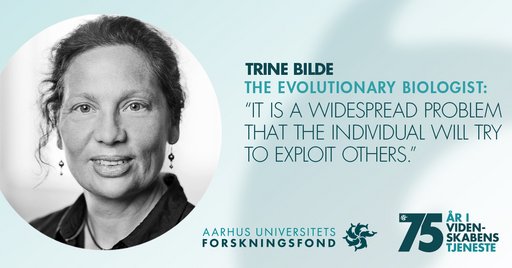
The evolutionary biologist:
‘It is a widespread problem that the individual will try to exploit others.’
Professor Trine Bilde conducts research in, among other things, the ways in which animals and humans cooperate, and she has found that even cannibalistic spiders are capable of working together with others.
My greatest Eureka moment was when I discovered social spiders – i.e. collaboration between individuals who are otherwise cannibalistic predators! Collaboration requires that you are willing to make a commitment to the community, but how do animals find out when it pays off to cooperate? It is a widespread problem in the human world as well, because the individual will always try to exploit others. I have since conducted research in an attempt to understand why animals and humans cooperate and which factors help to maintain 'justice' in the collaboration.
What led up to my realisation was my interest in evolutionary biology. The world of nature is wondrous, and when you study the incredible adaptations that exist in the animal kingdom – everything from colourful feathers and giant antlers that shall attract the right partner, to physiology adapted to survive long dives into the deep ocean – new realisations emerge of how utterly magnificent evolution really is.
I felt most deluded when I had completed my PhD and had been employed as a research fellow for a number of years, but still did not know if I would be able to obtain permanent employment. The career path in the research world is a tough elimination race, but it is also exciting, and you have unique freedom to organise your research as you please. But it was a strange feeling to be so enthusiastic about your profession, and then not knowing whether you would be able to carry on.
I knew that I wanted to work with evolutionary biology when I discovered that in order to understand the world we live in, you have to understand how evolutionary processes take place. ‘Nothing in Biology Makes Sense Except in the Light of Evolution’ is a central quote by the evolutionary biologist, Theodosius Dobzhansky, from 1973. It cannot be articulated any better than that.
My research is relevant to other people because I study the adaptation of animals to the surrounding environment and the ever-changing environmental changes that the world is experiencing. It has a huge impact on the prevalence of the species, on the survival of the insects, on the crop production for foodstuff, on the dynamics of the climate – with enormous consequences for the nature we are so completely dependent on, even for very basic things like food and drinking water.
I received funding from the Foundation to invite international researchers to Denmark to discuss and plan new ways in which we can understand the impact of the environment on biodiversity and the prevalence of the species and understand how climate change affects individuals and populations in the wild.
The support from the Foundation meant that we could launch new research initiatives in the field, share current knowledge, develop new ideas, involve new younger researchers in the collaboration and work on joint applications for international grants.
I am most proud of my work when, in collaboration with my research team, I find the solution to a research problem that we have been working on for a long time. We have an amazing group of researchers working interdisciplinarily, and it is a pleasure to develop and implement new projects.
Right now, I am studying which mechanisms allow adaptations to the climate, for example to extreme temperatures. I work in an interdisciplinary way with geneticists, microbiologists and chemists to delve into various mechanistic processes.
BIOGRAPHY
Trine Bilde
Professor of Evolutionary Biology at the Department of Bioscience at the University of Aarhus.
Biologist and in 1999 PhD from the University of Aarhus.
Support from the Aarhus University Research Foundation in the form of a Sandbjerg grant in 2017.
P.V. Glob
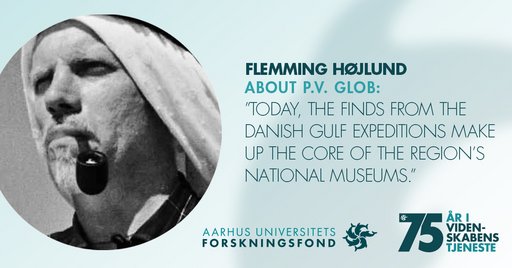
Flemming Højlund about P.V. Glob:
‘Today, the finds from the Danish Gulf expeditions make up the core of the region's national museums.’
Professor, State Antiquarian and Adventurer P.V. Glob (1911-1985) found evidence that Bahrain was not simply a burial ground for the surrounding countries, says Flemming Højlund, former Head of Department at the Moesgaard Museum and Editor of ‘Glob og Paradisets Have’ (Glob and the Garden of Eden).
P.V. Globe's greatest Eureka moment was probably when in 1954, he discovered that a Portuguese fort on the northern coast of Bahrain in the Persian Gulf had been built on top of the ruins of Dilmun's ancient capital. This was the beginning of 25 years of excavations of the legendary Dilmun culture, which four thousand years ago was responsible for the trade between the major cities of Mesopotamia and the Indus Valley. About 100 students and staff at the University of Aarhus and Moesgaard Museum participated in the investigations.
What drew Glob to Bahrain was the fact that the island was covered by the world's largest collection of burial mounds. Historians were of the opinion that the island served as a burial ground for the neighbouring countries, but Glob did not believe that, as the island was also known for its rich fresh water sources, which should have been able to support a resident population. It was a historic breakthrough when Glob was able to show that it was Bahrain's own population that was buried in the many mounds.
He was hooked on his profession when he, as a boy, participated in his father's excavations in the Kalundborg area. His father, Johannes Glob, was a painter, but also an avid amateur archaeologist.
Glob's research is relevant because he has shown that a desolate and inhospitable area along the east coast of the Arabian Peninsula in ancient times was the home of widely travelled merchants who established contact between the greatest civilisations of the time. Today, the finds of the Danish Gulf expeditions make up the core of the region's national museums and have shaped the historical identity of the local population. Six archaeological sites discovered and excavated by the Danish expedition appear on UNESCO's World Heritage list.
He received support from the Foundation for, among other things, studies of the archives of the National Museum – a museum where some years later, he became the Director.
I think he was most proud of his work when, in 1970, he hosted the Third International Congress of Asian Archaeology held in Bahrain. Here, archaeologists from all over the world were introduced to the results of the Danish excavations, Dilmun's fortified ancient capital, the Barbar temples, the temple well at Umm as-Sujur, the beautifully decorated, round stamp seals and the Royal Mounds of Aali.
BIOGRAPHY
P.V. Glob (1911-1985)
Professor of Archaeology at Aarhus University, Head of the Prehistoric Museum (now Moesgaard Museum), State Antiquarian and Director of the National Museum.
Master of Arts and Doctor of Philosophy.
Support from the Aarhus University Research Foundation in 1952 for further studies on rock carvings and for studies of the archives of the National Museum.
Peter Lauritsen
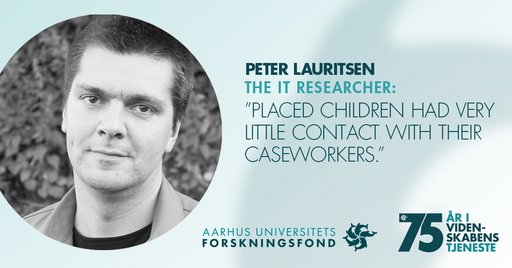
The IT researcher:
‘Placed children had very little contact with their caseworkers.’
Professor Peter Lauritsen conducts research into e.g. IT-based communication, and his most trivial idea is also his best – using Skype to communicate with placed children.
My biggest Eureka moment is hard to pinpoint precisely. Most of the time, I think that realisations come creeping up on me rather than suddenly popping up. But I once got the idea that social workers could use Skype when communicating with placed children in other parts of the country. The most trivial idea ever – but it turned out to be much more complicated than I thought.
What led to my realisation was that I had heard many discouraging accounts of how little contact placed children had with their caseworker so, I thought, maybe IT could help. After all, I work with IT every day.
I felt most deluded at the time when I investigated how young people used the Internet in the Andes. I expected them to use it for education, for knowledge of other countries, to organise social movements and the like. They did those things, but they also watched a lot of porn.
I do not even remember having any doubts that I wanted to work within information science. It is everywhere, and it is necessary to understand how we shape the technology, and how it shapes us. Being able to help shed light on that relationship, I think, is extremely exciting.
My research is relevant to other people because many people are very aware of surveillance, and they want to use monitoring technology in an appropriate way. Here, I think we can help because we do not think of surveillance as a bad thing by definition, but try to elucidate both advantages and disadvantages.
I received support from the Foundation together with Anders Albrechtslund for a project on monitoring children, for example in situations where parents keep an eye on the whereabouts of their children or where public servants such as teachers and social workers need knowledge about vulnerable children.
The support from the Foundation meant that we now have empirical knowledge of how surveillance technology is used in families, just as we have theoretical studies of privacy and intimacy. It is an understanding of the relationship between surveillance and children that is quite unique.
I am most proud of my work when it makes a difference to people – for example people who work with children and who are starting to see new opportunities and problems in the information technology.
Right now, I am studying what happens to professions when they become ‘data-based’. What does it mean, for example, for the social work that you measure, test and rate children and thus become able to form digital duplicates of the children.
BIOGRAPHY
Peter Lauritsen
Professor MSO at Information Science under the Department of Communication and Culture at the University of Aarhus.
Master in 1994 and Ph.D. in 1999 from Aalborg University.
Support from Aarhus University Research Foundation in the form of an AUFF NOVA project on the surveillance society (with Anders Albrechtslund) in 2017.
Karen Siune
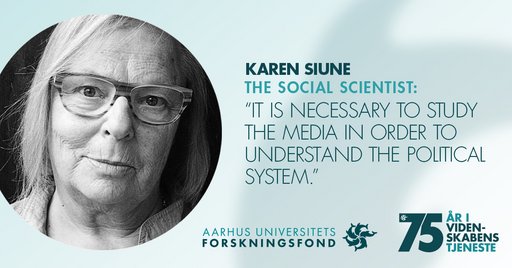
The social scientist:
‘It is necessary to study the media in order to understand the political System.’
In her long research career, former Head of the Danish Center for Studies in Research and Research Policy, Karen Siune, focused on the media's agenda-setting function in society.
My biggest Eureka moment is difficult to pinpoint as I felt joy every time a project was completed. My studies of the media's agenda-setting function have been some of the most satisfying to me as a researcher and the most rewarding for the democratic debate. Positive statements by foreign colleagues were particularly satisfying, and the media coverage of my research gave me the feeling that through my research I had a role in the democratic debate.
What led to my realisation were not individual events, but the understanding that studies of the role of the media in the form of systematic research-based knowledge were absolutely necessary to understand the way the political system functioned.
I knew I wanted to work within the social sciences with a point of departure in sociology. As a lecturer at the Department of Political Science, it was an obvious choice to study the role of the media in elections and referendums.
My research is relevant to other people as everyone is exposed to political influence through the mass media.
I received support from the Foundation for the analysis of political propaganda in connection with election campaigns in 1979.
The support from the Foundation meant that I was able to expand the comparative projects on the role of the media in politics, where the comparative perspective was key, both from one election to the next and in the analysis of elections and referendums in various EU countries, where precisely the European elections and my involvement in European research groups presented numerous challenges.
I am most proud of my work when the results have helped to make voters aware of the influence that they are constantly subjected to, especially in elections. The media's agenda-setting effect is extensive, regardless of changes in the media picture. The overall lines of the European political debate about EU membership have provided an ideal research background for understanding the current debate on Brexit. The media are still setting the agenda.
BIOGRAPHY
Karen Siune
Employed as a senior associate professor at the Department of Political Science at the University of Aarhus in 1984. Since then e.g. director of the Danish Institute for Studies in Research and Research Policy with responsibility for building up a sector research institute from 1997-2004 and head of centre at the Danish Center for Studies in Research and Research Policy from 2004-2010.
MSc Sociology in 1969 and Doctor of Political Science in 1982 based on the dissertation ‘Election Campaigns on Radio and TV’.
Support from the Aarhus University Research Foundation in 1979 for non-scientific assistance in collecting and analysing political campaigns.
Jens Chr. Skou
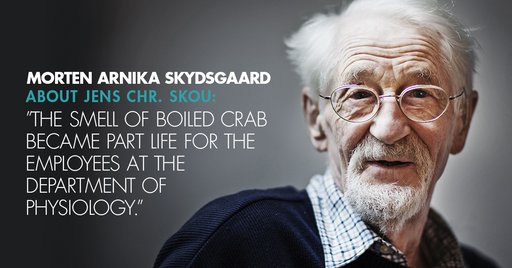
Morten Arnika Skydsgaard about Jens Chr. Skou:
‘The smell of boiled crab became part of life for the employees at the Department of Physiology.’
Nobel Laureate Jens Chr. Skou (1918-2018) discovered the sodium-potassium pump after years of tests with beach crabs. It is just as fundamental a building block in our cells as the DNA, says Senior Curator at the Science Museums, Morten Arnika Skydsgaard.
His greatest Eureka moment was probably when, in 1953, as a young scientist, he sat at a research library in the United States and read about an enzyme in the nervous system of giant squids. An American scientist had discovered the highly energy-consuming enzyme in 1948, but no one had questioned which function it might have. This ‘hole’ in the research that Skou spotted made him curious and set the direction for the next 35 years of his work as a researcher.
The work leading up to his big realisation was his legendary tests with thousands of beach crabs in 1954-56, during which he periodically conducted tests four to five days a week – and where the smell of cooked crab became part of life for the employees at the Department of Physiology.
He must have felt most deluded when, after several months of tests, he could not make sense out of his test results in spring of 1955. ‘I could not reproduce the tests and was in despair,’ as Skou recalled it. It turned out that there was a good reason for this as he discovered that on some days, the laboratory technician had prepared the crab nerves with a solution of potassium and on other days with a solution of sodium.
He was hooked on his specialty when he was a resident at Hjørring Hospital during World War II and found the medical work exciting. ‘I was like a fish in the water,’ Skou said many years later. He performed minor operations himself in the surgical department because – sheltered by the dark of the night – the senior registrar had to go out and pick up weapons for Danish resistance people. Skou's medical identity never left him and as a researcher at the university, he was the on-call GP for a number of years.
His research is relevant to other people because the sodium-potassium pump, which he discovered, is just as fundamental a building block in the cells as the DNA. It is found in the banana fly, in the fish, in the bird and in all other animals and humans. The molecule could be called the ‘battery’ of the cells, using 20% of the energy built up by food consumption. Just over a decade ago, Skou's heirs succeeded in linking defects in the sodium-potassium pump to specific diseases, including a migraine type.
He received support from the Foundation for his lifelong work of exposing the sodium-potassium pump structure and function. Work which other researchers at the university and in the rest of the world carry on today.
I think he was most proud of his work when, in December 1997, he stood on stage at the Stockholm Concert Hall in front of almost two thousand people as a world star, shook hands with the Swedish king and received the Nobel Prize. His name became known all over the world, and the prize framed his laborious scientific work for 40 years. It must have been some very intoxicating weeks for a modest person from Western Jutland, being the centre of so much positive attention from all corners of the world and in the streets of Aarhus, where citizens wanted his autograph.
BIOGRAPHY
Jens Chr. Skou (1918-2018)
Professor of Biophysics at the University of Aarhus 1978-88, Nobel Laureate in Chemistry 1997.
MD from the University of Copenhagen and Doctor of Medical Sciences from the University of Aarhus.
Support from the Aarhus University Research Foundation in 1982 for equipment for a project on the structure and function of Na,K-ATPase as well as the system's activity in relation to the contractility of smooth vascular musculature.
Bodil Due
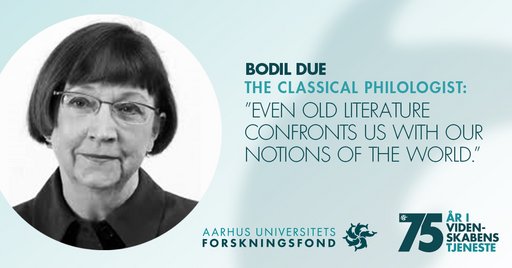
The classical philologist:
‘Even old literature confronts us with our notions of the world.’
Former Dean of the Faculty of Humanities, Bodil Due, chose a university career because of her interest in classical Greek literature, an interest that still consumes her today.
My biggest Eureka moment was when I started writing a dissertation and discovered how exciting it is to try to get to the very bottom of a text and then compare the result to other people's interpretations. I worked with a Greek writer who had a political career and at the same time was one of the first to teach rhetoric and who, with his own destiny, demonstrated the importance of communication.
What led up to my realisation was an acquired understanding of how we are mostly positively – but also negatively – influenced by words and their connotations.
I knew I wanted to work within my profession when, as a student, I began to teach and felt the joy of helping others get started. That joy has been my companion ever since.
My research is relevant to other people because literature of all kinds – also from earlier times – talks about people, their thoughts and actions. You are constantly confronted and challenged by your own ideas about the world.
I received support from the Foundation both in 1989 – as a researcher in classical Greek literature, for a small book written as a by-product of my dissertation, ‘Pantheia and Abradatas’ – and again in 1995, for a book entitled ‘Selection of Xenophon's Greek History, text, translation and comment‘. While dean of the Faculty of Humanities, we received support for the establishment of a humanistic PhD school. I also received support to ensure that my English was correct when I wrote my dissertation ‘The Cyropaedia, Xenophon's aims and methods’.
The support from the Foundation for the Faculty meant that we received a huge boost towards intensifying the PhD programme and making it more uniform for all PhD students.
I am most proud of my work when I am contacted by other researchers and asked to participate in professional discussions.
Right now, I am researching Greek history and literature in the 4th century BC. It was a time when many things changed in the Greek world, and it was the final period for Athens as an independent democratic city state.
BIOGRAPHY
Bodil Due
Former Associate Professor and Dean of the Faculty of Humanities at the University of Aarhus 1999-2011, currently acting as an advisor to the university management team in a number of different fields.
Master of Arts in 1967 and since Doctor of Philosophy in classical philology.
Support from the Aarhus University Research Foundation in 2007, on behalf of the Faculty of Humanities, for the development of the Faculty's research training.
K.E. Løgstrup

Svend Andersen about K.E. Løgstrup:
'To him, criticism was a distinct prerequisite for serious thinking.’
K. E. Løgstrup (1905-1981) found that as a theologian, he also needed to be a philosopher, says Professor Svend Andersen who is the head of the K.E. Løgstrup Research Centre at Aarhus University.
Løgstrup's greatest Eureka moment was probably when he realised that as a theologian, he also had to be a philosopher. He acknowledged that in today’s world, religion and Christianity are no longer a matter of course. Instead, today’s world is to a higher degree defined by natural sciences, and it is a dominant view that natural science is in fact the only well-founded way of looking at our existence. Philosophically, this view is called positivism, and if theology were to find a place for Christianity in modern thinking, it was necessary to break with positivism.
What led to his realisation were the studies which he completed as a young graduate while traveling in France and Germany. Amongst others, his travels brought him to Göttingen, where he studied with the philosopher Hans Lipps. About him, Løgstrup said that there were no others he had learned more from. What he learned was the form of analysis that is called phenomenology, i.e. careful descriptions of specific basic features of inter-human relationships. A good example is his analysis of trust in his 1956 main work The Ethical Demand.
He must have felt most deluded when as a researching minister he sympathised with the strict, Lutheran movement ‘Tidehvervsbevægelsen’, which had Søren Kierkegaard as its big idol. In Løgstrup’s opinion, this theological movement denied that ‘Christianity sends the Christian into the world to be absorbed in action by what is going on in it’. In the early 1960s, Løgstrup broke with the movement partly because it opposed internal criticism. And to the scientist Løgstrup, criticism was an essential prerequisite for serious thinking.
He was hooked on his profession already when in upper secondary school, ‘without any particular transition, he went from tin soldiers to philosophy’. It was especially the works of Immanuel Kant that challenged him. Kant's ‘scholastic conceptual apparatus and unreasonable syntax’ taught him, in his own words, to work thoroughly. He also spoke of his ‘aesthetic fascination with philosophy’ as he calls it. He saw something beautiful and pleasurable in philosophy. If the scientific work was cleansed of this aspect, it would become ‘a closed system’.
His research is relevant to other people precisely because it does not take place within a closed system, but to a great extent is about the basic features of human existence. His book The Ethical Demand, published more than 60 years ago, is still bought and read, even far outside the world of research. On the one hand, it contributes to making Løgstrup one of Aarhus University's international classic figures. On the other hand, it is read by so-called ordinary people. This is because the book argues in favour of ethics that are not found within a closed theoretical system, but belong in the concrete life of people.
He received support from the Foundation for an internship in France and England for the purpose of studying existentialism. In a way, this was a follow-up to his study travels as a young researcher. One of the main names of existential philosophy was the Frenchman, Jean-Paul Sartre, but Løgstrup also wanted to get first-hand knowledge of English philosophy. In his opinion, it was almost a duty for Scandinavian theologians and philosophers to acquaint themselves with the academic discussions both on the European continent and in the Anglo-Saxon world.
The support from the Foundation meant that he was able to expand his international network to the English-speaking research world. He stayed in e.g. Oxford, where he established personal contact with the prominent theologian Ian Ramsey.
I think he was most proud of his work when in 1974, he received the Amalienborg Award from the then Crown Princess Margrethe. The money that accompanied the award was earmarked for a French translation of Løgstrup's 1972 book Norm and Spontaneity. The award was both an acknowledgement of Løgstrup's work, a recognition of his importance as a prominent cultural personality – and an important basis for the international dissemination of his thinking.
BIOGRAPHY
K.E. Løgstrup (1905-1981)
Professor in Ethics and Philosophy of Religion, Aarhus University.
Master of Theology and Doctor of Divinity.
Support from the Aarhus University Research Foundation in 1952 for an internship in France and England for the purpose of studying current issues within existentialism.
Henning Lehmann

Former rector:
‘It can take a long time before you realise how much you learned on that side road.’
For Professor Emeritus and former Rector Henning Lehmann, Armenian church and cultural history is just one research area. For him, peer recognition is more important than whether his research has made any contribution to the gross domestic product.
I have had at least two Eureka moments. It is debatable which one is bigger. The first one was the professional satisfaction I felt when, in the mid-1960s, I identified the Greek version of three of the thirteen Armenian texts I worked with in my dissertation Per Piscatores. The second one was the surprise when, in 1978, in the Armenian patriarchate in Istanbul, I suddenly found myself holding an important Armenian manuscript from the 1300s. It was essential to my scientific work, and I had suspected that it had been lost in the chaos that struck Armenians in Turkey in 1915.
I do not remember having felt really deluded in terms of research, but according to the old dissertation scheme where you worked in ‘splendid isolation’, you would occasionally walk down a side road, including some dead-end ones. It can take a long time, indeed a very long time, before you know how much you learned on such a side road.
I sensed that I would probably like to get into research, already when I wrote the prize paper in 1957 and received a gold medal for it the following year.
The good question of usefulness and relevance usually applies to the significance of research in relation to the national product, industrial development or patient care. I can assure you that in this regard, my research has been absolutely useless. In all modesty, I am most satisfied when international peers recognise that I have contributed to the understanding of the linguistic, cultural and ecclesiastical processes that took place when Armenia became Christian 5-600 years before Denmark. In my world, this is extremely useful and relevant knowledge – for all church historians and all Armenians.
I received support from the Foundation in 1972 for the purchase of Armenian literature. As, according to the rules of the Foundation, the books must be transferred to Aarhus University upon my death, I have thus spared the state the expense of the books. Thus, albeit with the express knowledge and approval of the University and the Foundation, I may be violating the rule formulated in 1944 that the Foundation would never finance anything that the state should have paid for.
After retiring, I have studied both the history of the Foundation and various Armenian issues, including the stock of old Armenian books at the Royal Library in Copenhagen. Right now, I am considering whether the more general presentation of Armenian culture and history that I published in 1984 should be updated.
BIOGRAPHY
Henning Lehmann
Professor Emeritus and Rector at Aarhus University 1983-2002.
Master of Theology from Aarhus University in 1960 and Doctor of Philosophy from the University of Copenhagen in 1975.
Support from the Aarhus University Research Foundation in 1972 for the acquisition of Armenian literature.
Helle Prætorius Øhrwald
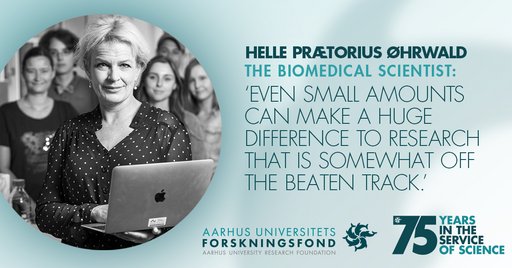
The biomedical scientist:
‘Even small amounts can make a huge difference to research that is somewhat off the beaten track.’
Professor Helle Prætorius Øhrwald is working to uncover new ways to fight bacterial infections such as urinary tract infection. It requires some wild hypotheses – and a lot of control tests.
I have been fortunate enough to have been the primus for several conceptual discoveries that have subsequently given rise to the establishment of new research areas. Fortunately, you often succeed in obtaining very exciting research results. But when you hold the evidence of a possible paradigm shift in your hands and know that just the few of us are involved in a project that suddenly identifies a fundamental new truth, you become humble and exalted at the same time. The latter was the case when my group and I showed that pore-forming, bacterial toxins utilise the body's own cellular signalling molecules to exert their harmful effects on the cells of the host organism. Overall, this means that you have a possibility to intervene and fight off the bacteria's attack on the body cells by means of the cells' own local signalling pathways.
What led to my realisation was a thorough preparatory work in the laboratory in tandem with thorough literature studies with pre-testing of our hypotheses in relation to existing knowledge – leading to completely surprising results that suddenly unveiled a gigantic lack in our understanding of the very key principles behind the way in which this group of bacterial virulence factors works. It was a simple, 'boring' control test by an exceptionally skilled PhD student which suddenly turned out not to be so boring after all and which revealed entirely new dimensions of our research.
I felt most deluded when we tried to prove our findings using in vivo models, i.e. living organisms, and it turned out to be even more complicated than we had originally imagined. After a terribly frustrating period, this allowed for reflection, thus helping to constructively target the future projects.
I knew I wanted to work within my field when in the medical degree programme, I was introduced to physiology and membrane transportation. It was the first discipline where you would not primarily be focusing on learning, but where you were able to independently deduce a new understanding of what goes wrong under pathophysiological conditions – i.e. the changes in the body's functions that accompany a disease.
My research is relevant to other people because my group and I work on the interaction between bacteria and host, with the goal of discovering new ways to fight bacterial infections. Our hypotheses try to challenge the conventions in hopes of identifying new ways to treat both more serious and milder urinary tract infections.
I have received support from the Foundation several times. The first time, in 2002, as a newly arrived researcher from the National Institutes of Health, I had to establish myself with the essential laboratory equipment to continue my research. The Foundation co-funded my first live cell imaging equipment, which was the basis for all my initial publications at Aarhus University – it is still working and is still being used. Later, I received funds for some lab assistance. This was during a phase where in my group, we had some exciting results coming our way, but not all studies had been finally completed. It turned out to be very significant support that helped bring home decisive control tests for the final publication of our findings.
The support from the Foundation meant that I could keep up the steam during the group's activities in critical stages up to a major conceptual breakthrough. It shows that small amounts at the right time and in the right place can make a huge difference to research that is somewhat off the beaten track during a phase of testing whether it will be all or nothing.
I am most proud of my work when the younger researchers in my group present their hard work, and it creates respect among colleagues for its innovation and potential relevance for the future treatment of patients.
Right now, I am studying the significance of pore-forming toxins for severe urinary tract infections, including blood poisoning. We are about to deduce which effector cells are the most important for the bacterial toxins. This allows us to isolate the best point of attack for interaction. In addition, we have exciting new findings about the reason why these pore-forming toxins actually make it easier for the bacteria to survive in the organism, and I believe that, once again, we are facing something very fundamentally interesting.
BIOGRAPHY
Helle Prætorius Øhrwald
Professor at the Department of Biomedicine, Aarhus University.
Master in 1994 and PhD in 2000.
Support from the Aarhus University Research Foundation in 2002, 2006 and 2009 for several medical research projects.
Anne Landau
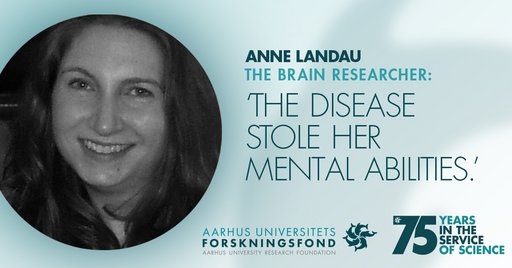
The brain researcher:
‘The disease stole her mental abilities.’
Associate Professor Anne Landau is conducting research on new and non-invasive ways to test the treatment of Parkinson's and depression, amongst others. It was her grandmother's disease that led her to that particular area of research.
My biggest Eureka moment I experienced as a PhD student at McGill University in Montreal, Canada. Here, I discovered that the FAS molecule, which is closely related to cell death, had the opposite effect and actually helped protect the brain in the models of Parkinson's that I was studying. The discovery was later published in the ‘Journal of Experimental Medicine’. We showed that the properties of a molecule to a large extent depend on the context – and that there are thus many opportunities to make new discoveries.
What led to my realisation was a study of mice with a defect on the FAS gene. These mice turned out to be more susceptible to a toxin that causes Parkinson's. We later showed that the ‘gene error’ is also found in people with Parkinson's.
I feel most deluded when I need to balance my working life and my family life. Both my PhD and my postdoctoral supervisor were women, but none of them had children, so I lack good examples of how to make the two worlds come together. With a two-year-old daughter, a six-month-old son and a research group, it is a constant balancing act that involves making tough decisions every single day. I hope that I can set a good example for my research group and help increase the opportunities for female researchers, so that in the future there will be more women at the associate professor and professor levels at Health and in the health field in general.
I knew I wanted to work within medical research when I watched my grandmother Czernia Kegel contract Alzheimer's. The disease stole her mental abilities. She was a Holocaust survivor, and when she got really sick, the only thing she could remember was the atrocities she had survived – those were horrible memories that haunted her several times each day in the period leading up to her death. Seeing her suffer that way motivated me to study neurodegenerative diseases.
My research is relevant to other people because we try to develop new tools to uncover the biological mechanisms that are found in depression and neurodegenerative diseases, such as Parkinson's. It involves, amongst other things, better use of laboratory animals and biological markers that can help us to monitor the development and response of diseases to various new forms of treatment. Hopefully this will lead to more gentle screening and, not least, better treatment of patients.
I received support from the Foundation for a pilot project in which we examined the effects of a very fatty diet as well as repeated exposure to sugar water on the reward centres of the brain. Amongst other things, we focused on the release of dopamine, which is closely linked to Parkinson's disease, by means of non-invasive PET scans of the minipigs. The Foundation financed the cost of the animals and the scannings.
The support from the Foundation meant that I was given the opportunity to develop a new collaboration where we got closer to understanding the addictive potential associated with the intake of sugar and the changes that occur in the brain when eating food that is too fatty.
I am most proud of my work when my students are doing well and are passionate about conducting research.
Right now, we are investigating two overall topics in the research team. One is the development of new models of Parkinson's in minipigs. The pig is an animal with a relatively large brain, suitable for PET scans and testing of new treatments – e.g. stem cells that produce dopamine. The second topic is the validation of a new substance that can be used in PET scans to map the density of synapses. Hopefully, our work can increase our understanding of the changes in the brain that, amongst other things, lead to neurological and neuropsychiatric disorders – and thus lead to new and better treatment methods.
BIOGRAPHY
Anne Landau
Associate Professor at the Department of Clinical Medicine (Translational Neuropsychiatry Unit and Department of Nuclear Medicine and PET Centre), Aarhus University.
MSc in 2002 and PhD in 2007 from McGill University in Canada.
Support from the Aarhus University Research Foundation in 2011 for the AU IDEAS project ‘Imaging the obesity epidemic: Cortical processing of liking, wanting and homeostatic regulation in minipigs’.
Per Bendix Jeppesen
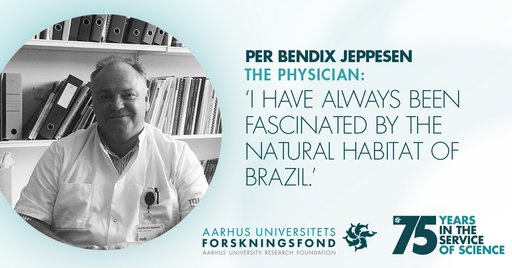
The Physician:
‘I have always been fascinated by the natural habitat of Brazil.’
Associate Professor Per Bendix Jeppesen conducts research into, amongst other things, insulin production. He made a great discovery when he found that a Brazilian plant could help diabetic patients.
My biggest Eureka moment was when I, as a PhD student, found out how the sweetener steviol glycoside from the stevia plant was able to treat type 2 diabetes by, amongst other things, increasing the secretion of insulin from the pancreas.
What led to my realisation was that I have seen how, in e.g. Latin America, extract from the stevia sugar plant was used to treat symptoms that are similar to type 2 diabetes.
I felt most deluded when we could not get our lab tests with islets of Langerhans (cells in the pancreas that produce insulin) to function. It turned out that the cause was too high summer temperatures in the lab.
I knew I wanted to work within my profession as I have always been fascinated by nature, especially the amazing nature of Brazil, with its huge diversity of plants and animals and, not least, by the knowledge regarding use of medicinal plants that the indigenous part of the native indian population has acquired throughout generations.
My research is relevant to other people because it has led to the understanding and use of natural bioactive compounds from plants in the treatment of e.g. diabetes (stevia plant) and osteoporosis (red clover extract). For many years, I have also worked with sports scientists to clinically test new nutrients, bioactive compounds and tailored training methods in athletes, diabetic patients and healthy individuals. In particular, I have worked on developing and testing new dietary interventions and supplements for different types of patients.
I received support from the Foundation to perform experimental studies to investigate how especially steviol glycosides from the stevia plant can improve the state of diabetes, but also for a science cookbook that describes how in a large project we could treat patients with type 2 diabetes by increasing their intake of indigenous vegetables from the Nordic Gene Bank (the MaxVeg project).
The support from the Foundation meant that we were able to identify how, amongst other things, steviol glycosides work in an animal model with diabetes.
I am most proud of my work when I see that the knowledge we have generated is being applied in practice.
Right now, I am studying how specially produced fruits and vegetables may reduce inflammatory conditions in patients with chronic intestinal infection such as Chron’s and ulcerative colitis. In addition, I am working to develop a new energy drink for top athletes, using a unique slow-release formulation with a special carbohydrate and protein composition.
BIOGRAPHY
Per Bendix Jeppesen
Research Associate Professor at the Department of Clinical Medicine, Aarhus University.
MSc in 1997 and PhD in medicine in 2002.
Support from the Aarhus University Research Foundation in 1999 in the form of equipment and an assistant for a project which studied the stevia plant’s ability to alleviate diabetes.
Morten Kyndrup
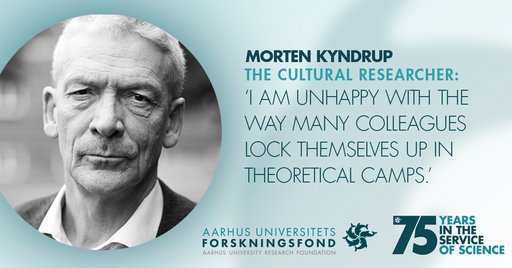
The Cultural Researcher:
‘I am unhappy with the way many colleagues lock themselves up in theoretical camps.’
Professor Morten Kyndrup has been director of Aarhus University's interdisciplinary Institute of Advanced Studies, AIAS, for eight years. He calls for more researchers to dare to ask critical questions of each other.
I cannot point to one particular Eureka moment in my research. There have been a few over the years. But they have all been moments when it suddenly dawned on me that by combining fundamentally different theoretical approaches, I could see entirely new analytical possibilities. Unfortunately, within the humanities, many people traditionally work within fairly rigid theoretical universes, or ‘discourses’ if you will. It is far too rare for research to think across, in connections between the different universes. It is the moments when I have suddenly been able to see that kind of non-obvious connections open up as fruitful opportunities that I have experienced my greatest Eureka moments.
The starting point for it all has been my fundamental interest in how art is functioning, i.e. its effects, both on a more general societal level and very specifically in the individual's encounter with the individual work. What art does, you might say. My starting point in ‘functional analysis’ of literature in particular led me, through reception aesthetics, semiotics and language theory, to a new understanding of meaning as something that always takes place as actions, ‘statements’. In this way, it has been possible to establish comparative analyses of the respective possibilities and limitations of the art forms – all for the purpose of exploring the special aesthetic generation of meaning, also in the light of the great historical changes of both art and culture.
I have felt deluded many times, especially when the sources of inspiration and the fields of interest have not been able to communicate with each other. Getting lost in ultra-complex theories without being able to find a solution – or an appropriate application. Furthermore, I must admit, I often feel a very frustrated with the way in which many peers nationally and internationally insist on locking themselves up in theoretical camps, in sanctuaries, without much interest in furthering the arts through critical, relevant research questions.
I have always been driven by a desire to understand the mystery of the work of art itself. What it can do and what it does to us. Not to ‘solve’ it and demystify the art. But the effect of the mystery will diminish if you are able to understand its mechanisms. And within the arts, scientific research has historically to a large extent either locked itself up within its subject area or reduced it by emotionally detaching from it. Been either too close or too far away.
My research is relevant to other people because the arts and the possibilities of the arts are there for all of us, but in their own way for us as individuals. Understanding the mystery would also allow us to utilise the arts better, and this applies to artists, scientists and art users alike – i.e. all of us.
The support from the Foundation meant it was possible for AIAS to be realised at all, and that it has now evolved into one of the world's leading institutes of its kind. Together with Aarhus University, the Foundation has paid almost two-thirds of the total expenses for AIAS 2012-22. The last third we have obtained externally, through EU programmes. With the build-up of AIAS, we have created a fruitful environment for top researchers from all over the world – for the benefit of the research as clearly demonstrated by the results. But not least for the benefit of Aarhus University, for our international reputation, and thus for our ability to continue to attract the best qualified researchers internationally. I am happy and proud to have been a part of that process.
In my research work, I am most proud when I experience being able to pass on scientific insights into the mechanisms of generation of meaning, imparting an understanding of the functioning of an aesthetic experience without simultaneously anticipating or directing the experience itself.
Right now, I am trying to become more all-embracing, more accurate and also easier to understand in my descriptive analysis of the aesthetic relation. I am on my way back to my professorship after the time as director of AIAS, and I look forward to spending much more time on research.
BIOGRAPHY
Morten Kyndrup
Professor in Aesthetics and Culture at Aarhus University since 1995 and – from 2012-2019 – director of AIAS.
Master of Arts in modern and comparative literature in 1978 and Doctor of Philosophy in 1992.
Support from the Aarhus University Research Foundation from 2013 onwards for development of AIAS in the capacity of director of the Institute until September 2019.
Miriam Flickinger

The management researcher:
’The managers of even the largest companies are only human.’
Professor Miriam Flickinger conducts research into management, and she has found that both employees and managers are often more biased than they realise.
My biggest Eureka moment was when I realised that management is more about people's perception of reality than reality in itself. Managers, employees and other stakeholders are more biased than they are actually aware.
What led to my realisation was my research into the way in which a manager's status in a company may be related to his or her dismissal. Since then, I have observed the same phenomenon several times.
I feel most deluded when I have collected and just started working based on very large data sets. This is the way it feels every time until some patterns begin to emerge.
I knew I wanted to work with management research when I gave my first presentation at a conference. It made me aware that there are many other scientists in the world who are interested in the same subjects as me.
My research is relevant to other people precisely because it shows that we all – even the managers of the largest companies – are only human. I find that quite reassuring myself with all its good and bad consequences.
I received support from the Foundation for my research into the way in which board members are selected for corporate boards. The support meant that I had the opportunity to conduct several different research projects simultaneously with my postdoc.
I am most proud of my work when I see that my research results make a difference in the companies.
Right now, I am preparing for my research stay at the Kellogg School of Management at Northwestern University in Chicago.
BIOGRAPHY
Miriam Flickinger
Professor at the Department of Business Management, Aarhus University.
Master and PhD from the Passau University. Has, among other places, worked at LMU Munich University.
Support from the Aarhus University Research Foundation in 2017 in the form of an AUFF Starting Grant.
Michael Svarer

The national economist:
‘You can explain the pairing of people with inspiration from economic theory.’
Professor Michael Svarer conducts research into what may be the most important decision in many people's lives – their choice of partner. And there is one factor in particular that explains quite a bit.
My biggest Eureka moment, amongst others, was when my research showed how strong the explanatory power is in the presence of search frictions when it comes to shedding light on pairing in the marriage market. There is a pronounced overrepresentation of pairing between people with the same level of education and even the same education. This overrepresentation is, amongst others, due to the fact that the partners have been attending the same educational institution – i.e. a market with low search frictions.
What led to my realisation was the option of linking different personal registers in Statistics Denmark's databases. With inspiration from the economic theory of market dynamics under imperfect information and with the presence of search friction, we statistically analysed data from the unique Danish registries which made it possible to understand the factors which influence pairing in the marriage market.
I felt most deluded when I spent a summer trying to prove the hypothesis of the Nobel Prize-winning economist, Gary Becker: that the exploitation of specialty gains in the marriage market supports pairing between men with a high earnings potential and women with a low earnings potential and vice versa. As with a lot of other factors, there is also here a clearly positive assortative pairing – i.e. we tend to hook up with people who are similar to ourselves.
I knew I wanted to work within my field when I discovered that I was able to combine economic theory and statistical methodology to make empirical analyses of socio-economically interesting issues.
My research is relevant to other people because it combines economic theory and empiricism to (hopefully) describe relevant socio-economic issues. This applies both to the perhaps most important decision in many people's lives – when they choose a partner – but also when the research field is the setup of the unemployment benefit system or the effects of the active labour market policy that draws on the same economic ingredients.
I received support from the Foundation to conduct empirical analyses of how so-called search frictions – i.e. the fact that market participants do not necessarily have an overview of all options in a given market – affect the dynamics of, amongst others, the labour market and the marriage market. Search frictions mean that it takes time to locate potential partners. Thus, in equilibrium there may be both vacancies and job seekers and thus a naturally positive level of unemployment.
The support from the Foundation meant that I was able to finance data purchases and student aid, thus allowing me more time to pursue other ideas.
I am most proud of my work when I can use my financial insights and analyses to make a difference when it comes to understanding economic mechanisms, and when my work can be used to refine the pursued economic policy towards a more efficient use of the resources that are available in the economy.
Right now, I am studying, among other things, how public spending affects economic core concepts such as employment and GDP through so-called dynamic effects. There is an ongoing discussion about the use of the rule of arithmetic in economic policy development. The goal is to help uncover the blind angle that is currently characterising the assessment of changes in public spending.
BIOGRAPHY
Michael Svarer
Professor at the Department of Economics at Aarhus University and ‘lead economic wise man’ (chairman of the Danish Economic Councils).
MSc in Economics in 1997 and PhD in Economics in 2001.
Support from the Aarhus University Research Foundation for an assistant to the project ‘Estimation of Matching Modes’ in 2002.
Osman Skjold Kingo
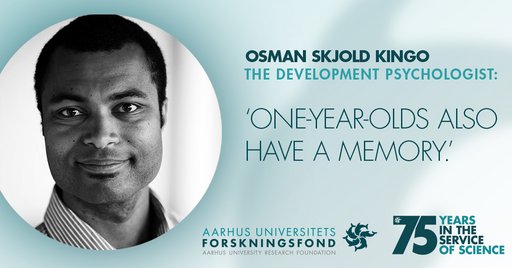
The development psychologist:
‘One-year-olds also have a memory’
Associate Professor Osman Skjold Kingo is conducting research into the memories of toddlers, and when he took a chance research-wise, he ended up demonstrating something no one believed existed.
My biggest Eureka moment was when it became clear that we had demonstrated that one-year-olds have a good memory. Even after two to three years, they could remember a person they had only met once before. We found that the children looked more closely at an entirely new person than they did at someone they had met only once at the age of 12 months. It was an expression of memory for the ‘well-known’ person, but not necessarily something the children themselves were aware of.
What led to my realisation was that we had taken a chance and studied something that we basically did not think existed or could be done. Based on previous empirics and theory, there was little evidence to suggest that you could demonstrate a memory of other people in children that young, after such a long time. But the opportunity to study it came up a little randomly, and so we decided to give it a try.
I felt most deluded when, after writing my PhD dissertation, I completely changed my area of research.
I knew I wanted to work with psychology when in upper secondary school, I became more and more occupied with the interaction between people's thoughts, feelings and behaviour and with everything that could be adequately described based on psychological theories.
My research is relevant to other people because general knowledge especially about children's mental development is of great importance for the way in which we understand the child's ‘good’ development and also the way in which we understand ‘lopsided’ or pathological development. For example, it is difficult to help children with different kinds of problems if we do not know what normal development typically looks like.
I received support from the Foundation to broadly promote my research work in connection with an award for best PhD dissertation.
The support from the Foundation meant that I felt more secure in my research and that in the long term, I could commit myself to the research world. I took that as a big pat on the shoulder.
I am most proud of my work when I am able to communicate it to lay people in such a way that it makes sense in relation to their own specific experiences.
Right now, I am studying, amongst other things, the spontaneous memories of toddlers as well as the importance of the parents' conversational style, i.e. the way parents ask questions about children's experiences, for the child's memory of events.
BIOGRAPHY
Osman Skjold Kingo
Assistant Professor in development psychology at the Department of Psychology, Aarhus University.
MSc in Psychology in 2003 and PhD in Psychology in 2010.
Support from the Aarhus University Research Foundation in the form of the PhD award in 2011 for best dissertation within the main subject area.
Lone Sunde
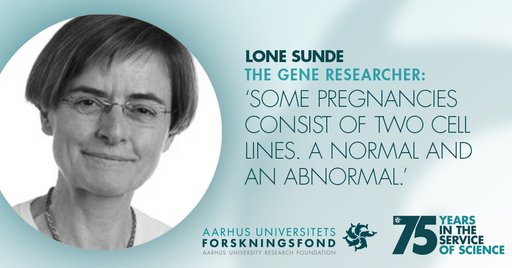
The gene researcher:
‘Some pregnancies consist of two cell lines. A normal and an abnormal.’
Chief physician Lone Sunde conducts research into molar pregnancies at cell level. Her research contributes, amongst other things, to uncovering hereditary disposition to infertility and placenta cancer.
My biggest Eureka moment was when we found out that some human pregnancies consist of two cell lines: a normal cell line with one set of genes from the father and one from the mother, and an abnormal cell line with two sets of genes from the father, but none from the mother. The genes in the two cell lines may originate from one egg cell and one sperm cell. The discovery gives us hints as to how the very first cell division may take place.
We already knew that with the rare form of pregnancy that is called molar, there will often be a majority of genes from the father – either two sets of genes that both originate from the father or three sets of genes, of which only one originates from the mother. In molar pregnancies, there is no viable foetus, and the placenta has a characteristic appearance with fluid-filled blisters. Therefore, molecular pregnancies are a source of infertility, but also a source of cancer, as approximately 10% of moles are followed by cancer of the placenta.
But it was new that there could simultaneously be cells with normal gene line-ups and cells with gene line-ups as the ones we knew from molar pregnancies. Sometimes, the two kinds of cells are mixed. This is called mosaicism, and then the pregnancy may have features of a molar and also features of a normal pregnancy. Other times, the two kinds of cells grow separately. The woman then has a twin pregnancy where one twin is normal and the other is molar.
What led to the new realisation were repeated, unexpected findings when we studied the origin of the genes in molar pregnancies. The idea that the unexpected findings might not be errors, but results, was shaped by countless discussions in large and small groups of ‘molar nerds’, including my former PhD supervisor Lars Bolund, PhD students and others with whom I cooperate.
I felt most deluded at the time when we studied moles with a new technique and thought that we had discovered that moles often lack certain parts of a chromosome. Fortunately, a colleague pointed out a source of error about this technique before we had time to publish the ‘results’.
I knew I wanted to work within my field, when during my medical studies, I realised that genetics is the subject area that allows you to look for the causes of biological phenomena and diseases to the greatest extent.
My research is relevant to other people because we shed light on what is happening at the time right around conception and the first cell divisions – i.e. basic research – and at the same time provide data that can be used specifically to help women with molar pregnancy – i.e. clinical research.
I received support from the Foundation to search for genes in mice that have the same function as the human genes NLRP7 and NLRP2. Those are the two genes that are involved in hereditary predisposition to molar pregnancies, and thus to infertility and risk of cancer.
The support from the Foundation meant that I could start a fruitful collaboration with Associate Professor Karin Lykke-Hartmann – who worked on egg cell maturation – about the study of NLRP genes. The NLRP genes are intriguing, amongst other things because several of them are important for imprinting other genes so that they can ‘remember’ whether they are inherited from the father or the mother.
I am proud of my work when I succeed in explaining something which we previously did not understand, and most proud when it is done in collaboration with colleagues.
Right now, we are studying, amongst other things, which genes – out of a person’s total number of 20,000 genes – have to be inherited in one father version and one mother version in order for early foetal development to go smoothly.
BIOGRAPHY
Lone Sunde
Chief Physician at Aarhus University Hospital as well as Clinical Associate Professor at the Department of Biomedicine. Previously, professor MSO at the same place.
Medical Doctor in 1981 and PhD in Genetics in 1992.
Support from Aarhus University Research Foundation in 2011 for an AU IDEAS project about genes and fertility.
Marianne Glasius
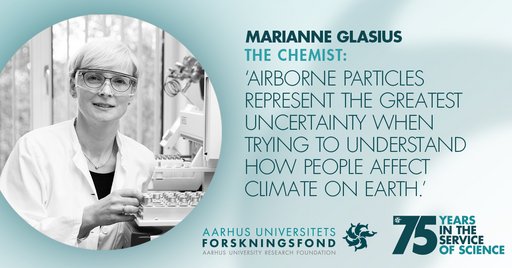
The Chemist:
‘Airborne particles represent the greatest uncertainty when trying to understand how people affect climate on Earth.’
Associate Professor Marianne Glasius is conducting research into the way in which air changes due to the man-made particle pollution, which each year causes the premature death of millions of people and which affects the climate on earth.
My biggest Eureka moment was the time when a few years ago we analysed molecular trace elements in airborne particles collected in the Amazon rainforest and discovered that surprisingly, these particles contain a certain type of substance called organosulfates. These compounds are formed when e.g. organic gases from plants are oxidised in the air and then react with sulphate in particles, typically from air pollution such as combustion of sulphur-containing coal and fossil fuels.
What led to my realisation was several years of work on developing analytical methods for organosulfates and the detection of them in particles collected in the Arctic, among other places. I came up with the idea for the study during a lecture on a major study regarding the ways in which air pollution interacts with the natural compounds of vegetation in the Amazon rainforest. During a research stay at the University of California at Berkeley, I collaborated with a research team that collected samples of particles during the project in the Amazon rainforest, and in this way, I was given an opportunity to test my hypothesis.
I felt most deluded when I started as an associate professor and had to build up a laboratory and research group from scratch. There were many new, exciting opportunities, but raising funds was difficult. Therefore, I am very grateful for the first large grants that enabled us to establish an internationally recognised research group.
I knew I would work within my field when, during a research stay in Italy at the European Commission's Joint Research Centre, I performed tests with oxidation – i.e. conversion – of natural organic gases from, amongst others, conifers which give them their distinctive scent. When these gases are oxidised in air, airborne particles are formed, and we did some of the very first analyses of the oxidation products in particles using advanced mass spectrometry, which produced completely new knowledge of chemistry in the atmosphere.
My research is relevant to other people because it addresses important issues within climate and environment. Particles affect the radiation balance and thus the climate on earth, so it is important to have a thorough knowledge of their sources and chemistry. Airborne particles represent the greatest uncertainty when trying to understand how human activities affect climate on earth. Globally, millions of people die prematurely each year due to air that is polluted with especially particulate matter, so we need to understand the sources of particles and the relevant processes in the environment.
I received support from the Foundation to purchase an advanced mass spectrometer. It allows us to determine the mass of individual chemical compounds very accurately and thus identify the types of molecules since the mass depends on the atoms which the molecules are made up of. We have used the equipment for a wide range of particle chemistry studies in both urban and remote areas. In addition, we have used it to study the chemical processes that occur when, under high pressure and temperature, biomass is converted into an oil phase and into by-products – it is research for the purpose of developing new biofuels and bio-based products.
The support from the Foundation was crucial for me to be able to build up a research laboratory with the latest and the best equipment, which has helped to make us a leader within this research area.
I am most proud of my work when we publish a scientific article and when one more talented student finishes his or her studies. It is great to finish a project and disseminate our results to other researchers who may use them to understand other issues. But the best part of my job is seeing a happy, newly graduated Master or PhD, whom I have known and guided over several years where they have developed and now are ready to embark on new assignments and contribute to the creation of a better society.
Right now, I am studying the chemistry of airborne particles and the formation of organosulfates in China. In addition, I work with colleagues and students to study the formation of particles from candles and their health effects in order to create a scientific basis for the development of candles that produce fewer particles.
BIOGRAPHY
Marianne Glasius
Associate Professor at the Department of Chemistry, Aarhus University.
MSc in Environmental Chemistry in 1996 and PhD in Chemistry in 2000.
Support from the Aarhus University Research Foundation in 2007 for the acquisition of equipment in connection with the project ‘High-Performance Liquid Chromatography – Quadrupole Time-of-Flight Mass Spectrometer’.
Julia Nafziger
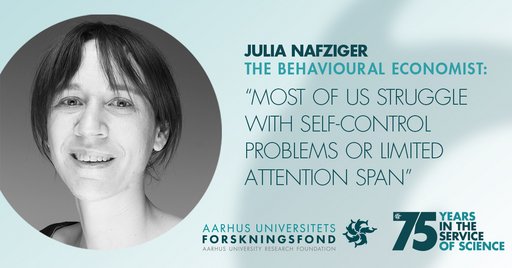
The Behavioural Economist:
‘Most of us struggle with self-control problems or limited attention span.’
Professor Julia Nafziger conducts research within behavioural economics and has found that some of our behavioural biases are good - because they keep other behaviorial biases at bay.
My biggest Eureka moment was when I realised that certain behavioural biases which – when seen separately – are considered negative, may actually be beneficial to people because they offset other negative behavioural biases. Specifically, I found that the behavioural bias known as ‘mental accounting’ – which is about splitting decision-making problems up into small parts rather than optimising everything at once – may actually be beneficial because it offsets behavioural biases such as self-control problems.
What led up to my realisation was when – with mathematical proof – I was able to show that my intuition was correct. In doing so, I started to look at the part of behavioural economics which I was researching in a new way.
I felt most deluded at the time when I had an interesting research question, but could not find an economic model that was appropriate as a tool to study it.
I knew I wanted to work within economics when it dawned on me what a wide field the applications of economic theory cover. Behavioural economics in particular allows me to work in an interdisciplinary manner within many different subjects within the social sciences.
My research is relevant to other people because most of us struggle with behaviorial biases, such as self-control problems or limited attention span. I am trying to establish which tools (e.g. nudging and self-control strategies) can be used to offset these behaviorial biases.
I received support from the Foundation to study the relationships between student behavioural patterns (e.g. dropout and internet surfing), their self-control strategies (including goals and mental accounting) and their personal traits (risk preferences and certain behavioural biases).
The support from the Foundation meant that I was able to complete a major questionnaire survey and an experiment and link the results to data from Aarhus BSS. In addition, I was able to build on the research and start three large, new projects with focus on reduced university drop-outs, on equipping young people better to get an education and on furthering their interest in the STEM subjects (Science, Technology, Engineering and Mathematics).
I am most proud of my work when it adds a small piece to the puzzle, thus helping to find solutions to social problems, and when I publish my work in reputable journals.
Right now, I am studying how to design ‘nudges’ in complex environments where consumers have a limited attention span.
BIOGRAPHY
Julia Nafziger
Professor at the Department of Economics, the University of Aarhus.
MSc from the University of Munich in 2014 and PhD from the University of Bonn in 2017.
Support from the Aarhus University Research Foundation in 2011 for the AU IDEAS project ‘What makes a student successful? A large-scale experimental investigation of behavioural correlates’.
Lotte Bøgh Andersen
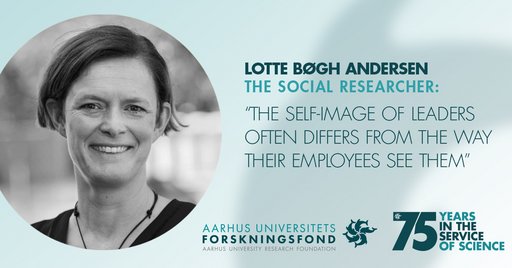
The social scientist
‘The self-image of leaders often differs from the way their employees see them.’
Professor Lotte Bøgh Andersen is conducting leadership research at the Department of Political Science, and in her experience, leadership development works better than you would think offhand.
My biggest Eureka moment was when we found out that leadership development actually works. We had done a big field test called LEAP. The test showed that the employees in the three test groups had actually come to view their leaders as more active within the particular forms of leadership in which we had trained them. It may seem evident that the employees would see their leaders act differently – be more active – after a leadership course. But it is not self-evident in a reality where there is often a big difference between the way in which leaders perceive themselves and the way in which their employees perceive them.
What led to my realisation was a large research project with more than 500 public and private leaders and their many employees. Together with a group of talented colleagues, I had designed and completed three different types of leadership training. Afterwards, we compared with a control group in which leaders and employees were monitored in the same way as in the three leadership development groups. Naturally, we had drawn lots among the leaders about who would join the individual groups.
I felt most deluded when my first conference abstract was rejected in 2001. Back then, I did not know that some workshops at those kinds of conferences were a closed club of older, male researchers. They merely accepted each other's abstracts and affirmed each other. Fortunately, things have improved a lot over the past ten years. And I myself do my best to give young researchers a chance - even if they have not yet mastered everything.
I knew I wanted to work with leadership research when I saw my first results within the field of municipal primary and lower secondary schools. I could see that good leadership has an impact on the value that is created for the citizens in our society. It was back in 2004 that I did an analysis of the relationship between municipalities and teachers and the significance hereof for the students' grades at the final examination.
My research is relevant to other people precisely because together with my colleagues I am trying to find out what works within leadership. ‘Works’ in the sense that initially, it leads to more motivated employees and subsequently to better results in public and private organisations.
I received a PhD award from Aarhus University Research Foundation for my dissertation in 2005, when I presented my first results within the field of leadership, where I am still working today.
The support from the Foundation meant that I myself realised that I could actually succeed in my research. I also believe that the award helped me to succeed in 2006 as a project manager for the first grant from the Research Council for Independent Research, Social Sciences. It is important to be able to obtain funding in order to do research that actually moves things along and is shared within the society.
I am most proud of my work when the leaders in public and private organisations can actually use the results that we have arrived at together. In my research, I am interacting more and more with ‘real’ leaders and employees, and at the recently held MatchPoints Seminar on leadership we could see how the new knowledge is used in many different contexts. It is good to see our research converted to concrete action.
Right now, I am studying how public organisations are getting better at meeting their goals. Together with other researchers from the Crown Prince Frederik Center for Public Leadership, I look at different types of leadership: data-informed leadership, distributed leadership, professional leadership, vision leadership and recognition. And then we explore how these types of leadership interact in a way that ensures better goal fulfilment in the public sector.
BIOGRAPHY
Lotte Bøgh Andersen
Professor and Director of the Crown Prince Frederik Center for Public Leadership, Department of Political Science, the University of Aarhus.
MSc Political Sciences in 2000 and PhD in political science in 2005.
Support from the Aarhus University Research Foundation in the form of an award for best PhD dissertation within the main subject area in 2005.
Hans Jørgen Schanz
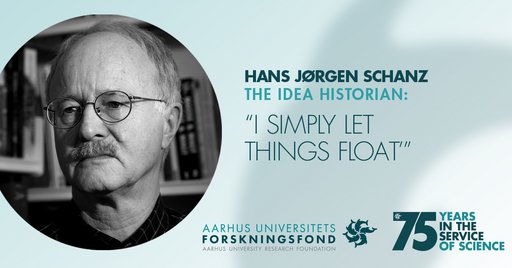
The idea historian:
’I simply let things float.’
Professor emeritus Hans-Jørgen Schanz lets time work for him when he sets out to think innovative thoughts about compelling social issues.
I did not have any real Eureka moment. My research is humanistic. But I have often had the feeling that I have succeeded in arguing in favour of an innovative view on a problem, including documenting and demonstrating why this view fruitful.
I have not had an experience of feeling radically deluded in my research. Before systematically setting out to solve a task – which incidentally I almost always decide upon myself and which has not been set by others – I allow myself ample time to think and try to come up with ideas of all sorts. I simply let things float. Usually, some contours will start to appear, and then I begin. If the beginning has been fruitful, the ideas will now have a specific direction.
I knew that I wanted to work within my profession as early as 1967, when I started on idea history. I was convinced of it because I hoped and expected that it could accommodate a wide range of intellectual and academic issues – often across the old well-trodden paths.
I have an expectation that my research is relevant to many people, both academics and the generally curious. I give many lectures in all sorts of contexts, from universities to popular gatherings and often, many people will turn up. In addition, I have published about 50 books and more than 500 articles. I think the relevance is due to the fact that I usually hit upon something contemporary that calls for clarification – or at least some information.
Over the years, I have received support for many of my books through the Aarhus University Research Foundation, most recently for the book ‘Ånd’ (Spirit) which was published in 2017.
The support from the Foundation meant - in cases where the subject was narrow - that the books could still be published. Besides, the support meant that the price of the books became manageable for both publishers and readers.
I am most proud of my work when I am very pleased with it myself, but naturally also when it attracts the attention of the public and helps to initiate new thoughts.
Right now, I am working on, well actually finalising, a book entitled ‘Menneskene og alt andet’ (People and Everything Else). It is an attempt to reconstruct how, from ancient times and until today, people have perceived themselves as different from everything else alive, but also as connected to everything. I am trying to shed light on the way in which human ethnicity has seen itself as different from everything else, how individualisation has been perceived, and how the two issues are embedded in our nature and cultural history.
BIOGRAPHY
Hans-Jørgen Schanz
Professor in the history of ideas at the University of Aarhus from 1992 and emeritus from 2018.
MA in the history of ideas in 1973 and Dr. Phil. in 1981.
Support from the Aarhus University Research Foundation, amongst others, in 2002 for the translation of a French essay. Most recently received support in 2017.
Vibeke Lehmann Nielsen
The Public Management Researcher:
‘Feeling lost is part of the realisation.’
By Jakob Jørgensen Vestergaard
Professor Vibeke Lehmann Nielsen conducts research within public management and would like to take a critical look at the way in which we organise our society.
My biggest Eureka moment was, in retrospect, probably when it dawned upon me during my PhD project that when colleagues were critical of my ideas and arguments, it was not necessarily because the ideas were completely wide of the mark. My arguments were just not sufficiently convincing. Belief in your own ideas and arguments, combined with the willingness to strive to make them clear, is an important companion in research. But being a researcher is a lifelong learning and realisation process, and you are responsible for your own learning. So, in many ways, the work days are filled with small, and hopefully sometimes not so small Eureka moments.
What led to my realisation was some repetitive criticism from my counsellors and colleagues in relation to a basic argument in my PhD dissertation. A criticism that I simply could not follow.
I felt most deluded back then, yes, phew … as a researcher you often have that feeling. It is part of the realisation process. As a human being, I feel most lost when there are so many tasks on my desk that I feel I only have time to stir one pot a little bit and then another one a little bit, and when I do not have time to immerse myself and do things properly. Then I try to ‘steal’ some time for immersion by prioritising homework days, where I shut out everything but a single project – such as writing an article – totally shut it out.
I knew I wanted to be a researcher when for two years in-between my master's degree and my PhD scholarship I worked ‘in the real world’ and missed time for reflection, the freedom to choose for myself what I wanted to study and how. It simply gave me peace of mind and body to step back behind the Department's yellow walls again.
My research is relevant to other people because it can hopefully contribute to a critical look at the way in which we organise society – and point out potential solutions.
I received support from the Foundation several times for both shorter and longer ‘research hibernations’ in Møllehuset.
The support from the Foundation meant that without any disruptions at all – and in beautiful surroundings – I was able to enjoy getting immersed in the workflow.
I am most proud of my work when practitioners recognise it and feel enriched by my research results. And when students, through guidance, brighten up when the light dawns upon them and feel joyful about their work.
Right now, I am studying variations in citizen behaviour vis-à-vis various public authorities as well as the state administration's interaction with mothers and fathers in visitation cases.
BIOGRAPHY
Vibeke Lehmann Nielsen
Professor in public management at the Department of Political Sciences, the University of Aarhus.
MSc Political Sciences and PhD.
Support from the Aarhus University Research Foundation, amongst others, in 2011 for a research stay at Møllehuset.
Per Aage Brandt
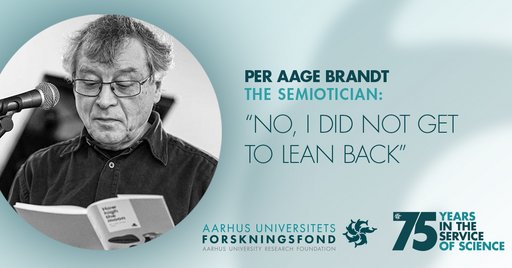
The Semiotician:
‘No, I did not get to lean back.’
Professor Per Aage Brandt is one of the world's leading researchers within semiotics. But first the subject had to be defined, and that took time.
My biggest Eureka moment was probably the discovery of the fundamental role of modal semantics in our generation of meaning. Let me explain: modality is what we mean when we e.g. talk about opportunity or impossibility; when we say that we shall, must, should, can do something or not. Without it, communication and thinking are not possible all. The new models and applications in textual analysis, semiotics and linguistics then led to the new research paradigm dynamic semiotics. It became the entry way to our basic research centre 1993-98 at the University of Aarhus and subsequently led to the semiotics programme.
What led to my realisation was the intense theory development in structuralist and semiotic circles that had taken place since the 1960s in Denmark and throughout Europe. On top of that, we saw the flourishing of cognitive research in semantics which invited collaboration on the new ways of understanding language, e.g. in the analysis of metaphors and mental spaces. The so-called Aarhus model for semiotic-cognitive blending of mental spaces derives from this collaboration. New models of diegesis, eviction and stemmatic grammar (the subject of my doctoral dissertation) sailed in the same waters, most recently including ecologically based socio-semiotics, which in turn leads to a new character theory. The development continues.
I felt most deluded when my first dissertation with the bleak title ‘Sandheden, sætningen og døden’ (The Truth, the Sentence and the Death) was rejected. If it was not possible to follow my rather straightforward, chorematic analyses of the relationship between spaces, forces, narratives, subjects and discourse, then how would the future look? It turned out quite well, thanks to the enthusiasm in my dear language programme, Spanish, and then the phenomenal working environment at the Center for Cultural Research, where after semiotics got its own place, up in the clouds in the top floor of the Trøjborg complex.
I knew I wanted to work within my profession when it became clear that I was not going to be a composer as I had first thought. Imagine being able to lean back while other people play your music so you do not have to practice! But no, I did not get to lean back. Rather, it turned into something that had to be tackled ‘head on’, as you say. But the subject had to be defined first, and it would be a long process.
My research is relevant to other people because (or if) it creates new realisations. That is what it is all about, and you never know if you will succeed. Semiotics is, after all, research in the generation of meaning, a kind of basic humanist research, and if any such new realisation can make humankind more insightful, sensible, critical and constructive as a part of social life, then why not? Furthermore, semiotics is most exciting.
I received support from the Foundation to publish works within an area which at that time did not have the necessary journals at its disposal because it was long regarded as very nerdy and different. It is still a bit different, but most humanists in Denmark now know what semiotics is, pretty much.
The support from the Foundation meant that the journal could be published and grow big internationally. Today it is called Cognitive Semiotics, still with the University of Aarhus in the editorial office.
I am most proud of my work when I succeed in some of what I hoped for, when it fulfils the expectations of all participants, is somewhat understood and is part of a larger context. It does not happen all the time though, far from it!
Right now, I am studying how to reconcile basic ecological social structure, characters and meaning, the basic structures of language and the configuration of the human psyche. It is a big loaf of bread for a single table, but my desk is so solid that you can safely jump and dance on it. The worst thing is almost the philosophical preparation. That is hard and difficult and must be started from the beginning, over and over again.
BIOGRAPHY
Per Aage Brandt
Professor from 2005-2011 and Professor Adjunct (sort of a semi-active emeritus) at the Department of Cognitive Science, Case Western Reserve University (CWRU) in Cleveland, Ohio.
MA in romance philology in 1971 from the University of Copenhagen and Doctorat d'Etat en sémio-linguistique from Sorbonne in 1987.
Support from the Aarhus University Research Foundation in 2002 for publication of Almen Semiotics (General Semiotics) No. 18. In 2007, the Cleveland journal became the Journal of Cognitive Semiotics, now just Cognitive Semiotics.
Marianne Qvortrup Fibiger

The researcher of religion:
‘It took me an entire year to recover from the shock.’
Associate Professor Marianne Qvortrup Fibiger is an expert in Hinduism, and she quickly found out that it is not easy to understand this world religion.
My biggest Eureka moment was ... well, that question is hard to answer as I believe I have been fortunately enough to have many. This is probably often the case within humanistic research because we do not discover a new form of treatment or a new DNA chain. But some of the most interesting moments have been where, with field work and specific empiricism about Hinduism as a religion, I have helped shape new theories. That, I think, is fantastic. During my field work among Hindus in Mauritius, I could e.g. observe that secularisation with a new understanding of Hinduism has not led to the phasing out of certain archaic rituals. Rather, they have been strengthened as they fit well into a modern performance culture.
What led up to my realisation was long-term field work and a lot of observations. I have done field work in several places in the world: Punjab in North India, Kerala in South India, Sri Lanka, Mauritius, England, Kenya and Denmark. Everywhere I have focused on the living Hinduism. Time and again, I have therefore encountered a Hinduism that I did not recognise from the professional literature. It says something about the difficulties in capturing Hinduism as a religion. It simply does not fit into the theoretical attempts to classify religions. But it also says something about religion as a dynamic and contextual phenomenon.
I felt most deluded at the time when I had only done field work in Punjab, Kenya and England. I thought that now I knew fairly well what Hinduism is like as a religion. But then I started doing field work in South India, Sri Lanka and Denmark among Tamil Hindus. Here, I came across a completely different form of Hinduism. I think it took me an entire year to get over the ‘professional shock’ that the encounter with a whole new form of Hinduism was. Of course, the easiest thing would have been to turn a blind eye to it, but I did the opposite and made a virtue out of watching that my image of Hinduism cracked. I never regretted it.
My interest in the science of religion slowly emerged due to of my interest in human behaviour and the significance of history, society and mythologies to man’s understanding of the world. That it became Hinduism is probably because during my studies, I was invited to do field work in Southall in the western part of London among the Punjabi Hindus there. Until then, I really thought I was going to specialise in Tibetan Buddhism, but I was quickly carried away by the great challenge that is the very core of work with Hinduism.
My research is relevant to other people because it helps to understand the importance of religion in today's world. It provides an insight that religions are dynamic and adapt to new conditions in order to still make sense to those who feel connected to them. That is why I have been particularly interested in exploring Hinduism outside India and in the ways in which Eastern concepts such as karma and practices such as yoga are exported to the West and are given new meaning here. That is so interesting!
I received support from the Foundation to do field work in Kerala and Tamil Nadu, where you find a strong Śhaktism, i.e. goddess worship, not least among lay people. Śhakti is a female divine dynamic energy that all goddesses possess, but it can also be expressed through human media.
The support from the Foundation meant that I was given a unique opportunity to uncover how goddess worship is one of the most widespread forms of Hinduism among lay people in South India - even though it is still not recognised as an independent tradition by many Indologists. The field work sharpened my researcher’s eye and meant that subsequently, I approached my research among Tamil Hindus in Denmark in a new manner. Suddenly, I was able to uncover patterns around a particular Tamil goddess temple in Denmark that I had not previously had an eye for.
I am most proud of my work, when my research can reach out broadly and help to give us a diverse understanding of religion, its significance and its new modes of expression. And here I am very lucky to have present-day Hinduism as my exploration. In my view, it is the one world religion that continues to challenge and hone any attempt to capture what religion is.
Right now, I am studying several different things. First and foremost, I follow the Sri Lankan Tamil Hindus in Denmark and study how their traditions are continuously adapted to Danish conditions, but at the same time are up for negotiation between the generations. I am also studying why female Hindu gurus seem to gain more and more appeal. And then I am interested in finding out how concepts and views of life with an Eastern background take root in the West, simultaneously adapting to Western conditions. This new and changed form can then be traced back to the East again as it fits well with e.g. a changing India with a growing middle class and increased secularisation. In other words, religion circulates and moves. And as a researcher I try to move along.
BIOGRAPHY
Marianne Qvortrup Fibiger
Assistant professor in religious studies at the University of Aarhus.
MA in 1992 and PhD in 1999 with a dissertation about the Sri Lankan-Tamil Hindus in Denmark.
Support from the Aarhus University Research Foundation in 2006 in connection with the project ‘Shaktism as a local and global phenomenon’.
Jens Chr. Djurhuus
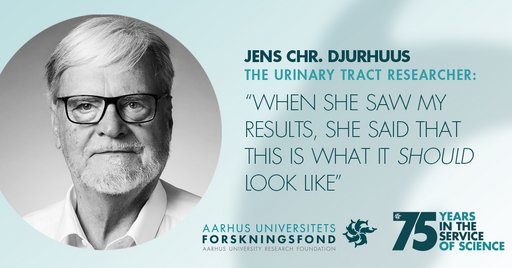
The Urinary Tract Researcher:
‘When She Saw My Results, She Said That This is What it Should Look Like’
Professor emeritus Jens Chr. Djurhuus has helped change the view on children peeing in bed. Now they are no longer punished, but treated.
I have had at least two great Eureka moments. The first moment happened before I came to Aarhus. In my animal experimental work, I was relegated to working with pigs unlike the few others in the world who studied the so-called upper urinary tract. My results were different from theirs because they worked with dogs and rodents. I was close to being bullied for working with pigs until I met Edith Bülbring in Oxford. She was the ‘mother’ of all smooth muscle research and at the time 82 years old. When she saw my results, she said that this is what it should look like in the case of smooth musculature. That was the moment when I realised the importance of animal model choice, and when it comes to the pig, that it looks very much like humans. It became a landmark in my career and for what I managed to establish after I came to Aarhus.
The second moment was when in Aarhus we managed to realise my dream of investigating why children pee in bed. Basically, I thought there was something wrong with the bladder function. However, in the children we examined, the bladder function was normal. We saw something else though, i.e. that they had a much higher urine output at night than what is usual. We compared to children who were not bedwetters. We found a clear difference and therefore proceeded to provide a substitute for the lacking increase in the hormone that controls the nocturnal reduction in urine production. This has led to increased focus on and understanding of bedwetting worldwide and a radical improvement in the children's situation. Research is still ongoing because naturally, it is not all bedwetting children who have a high urine production. Rather than one explanation, now there are many.
What led to my realisation was probably a touch of serendipity.
I felt most deluded at the time when I was alone with my research results that deviated from the rest of them.
I knew I wanted to work within my profession when in the 3<font size="2">rd</font> year of the upper secondary school, I had a teacher whose teaching was so stimulating that it made me want to become a doctor. He was one of the few people at the school who did not wear a doctor's signet ring, but also one of the least frustrated when it came to the ‘burden’ of having to teach students in upper secondary school.
Our research is relevant to other people because it has changed the view on children peeing in bed, shifting from punishment, mental deviation and something real doctors should not deal with to a more diagnostic and treatment-oriented approach.
I received support from the Foundation for several parts of my research within bedwetting, but also for other parts within my area of responsibility at Aarhus University. The support meant that we could realise many facets of the research at the Department of Clinical Medicine.
I am most proud of my work when it engages and stimulates young people to be curious and pay attention to the unexpected. And not least when you hear from a child and its parents that now there are dry nights.
Right now, I am studying by glancing over the shoulders of other researchers – as I am emeritus – the development of poor bladder function. It is research that has an impact on how we deal with the consequences of congenital valve creation in the urinary tract of boys.
BIOGRAPHY
Jens Chr. Djurhuus
Professor emeritus from 2016 at the Department of Clinical Medicine, Aarhus University, which he has also managed for many years.
MD from the University of Copenhagen in 1970 and DMSc in 1980 from the same university.
Support from the Aarhus University Research Foundation in, amongst others, 1999 for orthopaedic surgical research.
Lise Bek

The Art Historian:
‘It was not just provincial brick masonry.’
On a study trip to ancient Pompeii in 1968, Professor Emeritus Lise Bek found that the houses of the ancient Romans were carefully designed, even though they were not geometrically rigorous.
My greatest Eureka moment was when, on a study trip to ancient Pompeii in 1968, I arranged myself in the proper Roman way, laying down and supported on the left elbow at the place of honour in a garden triclinium – which is a dining setup with three benches in a U-form. From there, from that asymmetrical, lying position, I could see with my own eyes that the visual impression along the diagonal axis fell into place as a symmetrically composed harmonious visual image.
The same result could be seen in other city houses and in other locations – in reception rooms, panorama windows and the like, where the optical axiality and the diagonal views repeated themselves in the floor plan in different variants. It strengthened my assumption that when constructing houses in ancient Rome, they exploited the optics of the Hellenistic naturalist Euclid. So, they built based on the then prevailing human way of seeing things, and not on the Euclidean geometry which became the norm from the Renaissance onwards.
In its static harmony, the geometry represented the perfect, the eternal. It therefore gained an almost divine status as otherwise reserved for the gods and their temples. The optics, on the other hand, with its dependence on the human view represented the temporal world in all its volatility.
It was this ambiguity in the architecture and the architectural planning that the Renaissance put an end to by its humanisation of geometry or, if you will, its apotheosis of man as presented in my dissertation.
What led to my realisation was my incredulity that the ordinary Roman house – with its carefully thought-out design based on function, interior climate as well as aesthetics and preferably paired with a sophisticated decoration – should be simple provincial 'brick masonry' as previously claimed due to the twisted lines and angles of the houses. On the contrary, it was actually built using a far more advanced architectural principle than the geometric one. As the facade was more important than the floor plan, the effect of the finished building as a visual image had to be taken into account right from the initial outline.
I felt most deluded when I tried to substantiate my discovery at that time because there was very little literature and only a few studies on the subject. In addition, there were no viable art historical methods for analysing my material. I therefore had to work in an interdisciplinary manner, which has benefited me greatly ever since.
I knew I wanted to work within my field already when I completed upper secondary school followed by a period at a folk school in 1956 when I enrolled at the newly established Department of Art History at the University of Aarhus.
My research is relevant to other people because the visual arts in the form of architecture and images make up an essential part of the framework of people’s everyday life. And because it is through the arts that our way of seeing and perceiving, understanding and interpreting reality is reflected in its purest form. Through the arts we can find ourselves and orient ourselves within our society, as I have tried to argue in my later works.
I received support from the Foundation for, amongst other things, the publication of the book Virkeligheden i kunstens spejl in 1985-88, the revised English edition of that book Reality in the Mirror of Art in 2003 and for the book Måltidet som stilleben: Fra offergave til fastfoodobjekt (The Meal as a Still Life: From Offering to Fast Food Object in 2018. In addition, I have received support in connection with the arrangement of several of the interdisciplinary Sandbjerg seminars for architects, urban planners and humanists in collaboration with, amongst others, the country's architectural schools, and for the publication of the results.
The support from the Foundation meant that I could go on the necessary journeys in connection with the search, inspection and processing of the material related to the various projects - and that the publication of my results could appear in a proper art-historical manner.
I am most proud of my work when the results can open the eyes of ordinary people to the arts and their importance both to the individual and to the society. But also, when professionals can use my results as a research or practical tool, e.g. when, after the Pompeii earthquake in 1987, my theory of Euclid's optics and the resulting diagonal views in Roman buildings were included as part of the foundation for the restoration work.
Right now, I am studying the relationship between Dante's Divine Comedy and the visual arts, focusing in particular on the visual and spatial relations as well as figure layout and interaction. Here Dante, with his famous work, stands as a transitional figure between the old way of seeing things and thinking in the Middle Ages and during the Renaissance and the modern way of both seeing and thinking. At the same time, Dante is also an ever-present source of inspiration, and my contribution shall help mark that in 2021, it is 700 years since he died.
BIOGRAPHY
Lise Bek
Professor emeritus in the history of art, the University of Aarhus.
MA from the University of Aarhus in 1966 and DPhil from the University of Copenhagen in 1980.
Support from the Aarhus University Research Foundation, amongst others in 1978 for the photo exhibition 'Art on Rocks' in the lobby of the University of Aarhus on early Christian churches in Armenia as an introduction to an international, interdisciplinary seminar on Armenian church art and theology.
Johan Fjord Jensen
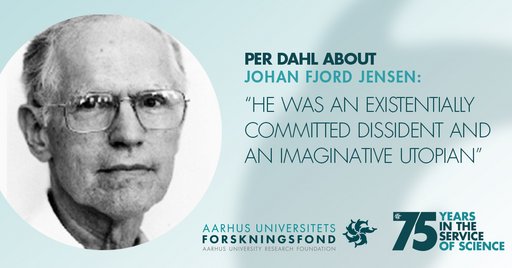
Per Dahl about Johan Fjord Jensen:
‘He was an existentially committed dissident and an imaginative utopian.’
In the 1980s, Professor Johan Fjord Jensen (1928-2005) opened the narrow literary studies to the outside world. These are the words of Associate Professor Emeritus Per Dahl about his old colleague from literary history.
Fjord's Eureka moment was probably when, during the 1960s, he effectively opened the then very narrow and philologically founded literary studies. He did this partly by introducing and systematising Anglo-American New Criticism and partly by introducing literature research to the educational-political debate. In the following years, both were followed up by ideological-critical analyses.
The work that led to his realisation and initiative can be found in the 1966 essay collection Homo manipulatus which contains analyses of the cultural-radical tradition. In this connection, one of Fjord's first myth analyses is unfolding. The very distinctive point it made included not just the reading of an advertisement, but also focusing on the social context in which the advertisement works and which may lead to manipulation.
Here lies the core of the large, ground-breaking collective projects where Fjord became the organising and analytically driving force. In the first instance, it was about trivial literature such as the weekly magazine Søndags-B.T. and comic strips. On a large scale, it was unfolded in the nine-volume Dansk litteraturhistorie (Danish Literary History) that was published in 1983-85 and later came in two further editions. Nine volumes in three years was a literary-political triumph. Fjord was also engaged in the launch of the journal Kritik (Critique) together with Aage Henriksen and – from a university-political point of view – in the establishment of humanistic science theory, basic programmes, interdisciplinary programmes and the Jysk Open University.
Certainly, Fjord was an existentially committed dissident and an imaginative utopian, but those traits contained a constructive duality, a willingness to ‘live under conditions which simultaneously we seek to escape from’, as he put it.
He must have felt most deluded during the first years of his studies. Originally, he enrolled (in 1948) in history and classical studies, then switched to Danish, but gave up and became a conscientious military objector for two years, now with plans to return to national economics. That he also gave up and went back to Danish with a renewed love of literature, but gave it up once more, now in favour of ordinary and comparative literature, at the time called literary history. He finished with a dissertation on Turgenjev which was honoured with the university's gold medal and published in 1961. It once and for all established Fjord's reputation as a literary analyst, methodologist and systematist, and it is still a major work within comparative literature research.
The work by Fjord that has reached the widest audience is, however, probably Livsbuen (the Arc of Life) from 1993. The book is about adult psychology and life stages, not least the Third Age and the opportunities that are open to seniors who in the best cases have both the health, energy, curiosity and resources to launch and unfold anything they want.
When Fjord became a professor in literary history in 1974, one of the challenges was to continue the Brandes archive which was closely linked to the establishment of the General and Comparative Literature programme at Aarhus University in 1939. Here, Paul Krüger had for many years built up an extensive Brandes archive, but upon his death in 1965, the work had stopped. Thanks to support from the State Humanities Research Council and the Aarhus University Research Foundation, it was reorganised in the early 1980s and has since been a crucial resource for almost all later Brandes research, most recently in connection with the digital release of Brandes' Main Currents in 2019.
BIOGRAPHY
Johan Fjord Jensen (1928-2005)
Professor in literary history, the University of Aarhus, 1974-92, and honorary doctor at the Universities of Bergen and Minneapolis.
MA in 1959.
Support from the Aarhus University Research Foundation in 1981 for the preparation and publication of Georg Brande’s Bibliography (together with Per Dahl).
Ellen Margrethe Basse
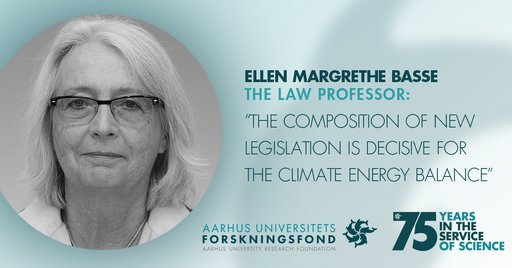
Professor Ellen Margrethe Basse is a researcher within environmental law. It all started with 3,000 appeals board decisions and the acquisition of the first computer for the Institute of Law back in 1984.
My greatest Eureka moment was when, in the 1980s, on a solid empirical basis I was able to uncover and explain how politicians – in collaboration with interest organisations and government officials – steer the administrative practice in different directions through the regulations that stipulate the composition of appeals boards.
What led to my realisation of the concrete significance of the public complaint systems was when I incorporated various political theories into my forensic analysis. I studied decisions made by one and the same appeals board – but with different member compositions - within 11 different areas of law.
I felt most deluded at the time when I had read the well over the 3,000 decisions made by the Environmental Board of Appeal, the composition of which was different from one area of law to the next. Based solely on the traditional way of looking at the system of justice, I could not immediately explain the differences in the decisions.
I knew I wanted to work on environmental research when I gained insight into the complexity and inconsistency that characterise the extensive environmental legislation and practice.
My research is relevant to other people because climate, energy and environmental legislation and practice basically relate to everyone: The composition of new legislation, as it is laid down internationally, regionally or in the EU and Denmark, can be crucial in ensuring protection of the biodiversity, the climate energy balance, clean air and water quality, quality food and so on – for both present and future generations.
I received support from the Foundation in 1984 to buy the first computer for the Department of Law. The Department had already bought the computer for educational purposes for DKK 70,000, which was a lot of money in the 1980s. But in order for me to use it in my research, I had to raise some external funds. This is where the Foundation helped. In 1999, I received support to conduct one of many Nordic researcher training courses and in 2016 I received support to invite a visiting researcher from the Political Science Department, University of Northern British Columbia, Canada, to a stay at the Department of Law.
The support from the Foundation meant that the computer for which I received financial support in 1984, allowed me to categorise and analyse more than 3,000 appeals decisions. The support provided in 1999 to conduct Nordic PhD courses for researchers within environmental regulation helped us to establish a Nordic environmental regulation research network, which was later developed into a European network. The support for the visiting researcher stay in 2016 made it possible to write an interdisciplinary, internationally published article on the lack of transparency that characterises the decisions on uranium extraction in Greenland.
I am most proud of my work when some of my former PhD students and graduate students choose a university career within the field of environmental law or choose a career where, in practice, they work with environmental regulatory tasks.
Right now, I am studying the development and content of environmental legislation at international, EU and national level. Amongst other things, I am looking at the interaction in which the European Court of Justice plays an important part. The significance of digitalisation for the development of environmental law is another key research area.
BIOGRAPHY
Ellen Margrethe Basse
Professor of Environmental Law, Department of Law, Aarhus University.
LL.M, LL.D and jur.dr. (h.c.).
Support from the Aarhus University Research Foundation in 1984 for acquisition of a computer for the Department of Law, in 1999 for development of a researcher training course and in 2016 for the stay of a visiting researcher.
Johannes Sløk
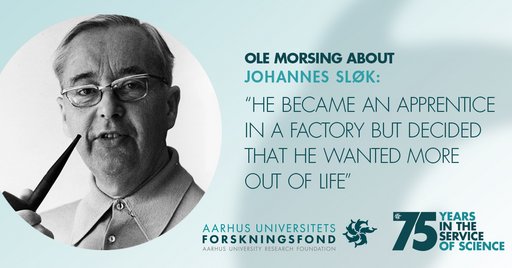
Ole Morsing about Johannes Sløk:
‘He became an apprentice in a factory, but decided that he wanted more out of life.’
‘Professor Johannes Sløk (1916-2001) was an apprentice at a factory for electrical articles prior to becoming one of our greatest theological thinkers’. These are the words by Ole Morsing, Professor Emeritus in history of ideas. Ole Morsing is the author of the book ‘Løgstrup and Sløk’.
His greatest Eureka moment was probably the time when, as a 15-16-year-old, he got to spend a holiday with a doctor’s family and someone slipped Kierkegaard's Works of Love into his hands. Sløk himself writes in his so-called ‘memory lapses’, Me and Godot, that until then he had been reading the usual ‘steamroller novels’, but that the meeting with Kierkegaard was an awakening for him.
The work leading up to the realisation was the holiday he got to spend with the doctor who was passionately occupied with everything spiritual and who, to the amazement of Sløk, had become enamoured with him. He ‘became more important to my destiny in life than any other human being,’ he wrote in his memoir.
He must have felt most deluded when first, he had to work as an apprentice in a draper’s shop and after the trial period refused to sign the apprenticeship contract. Next, he became an apprentice in a factory for electrical articles, but, in his own words, he could not possibly accept that there would be no more to life. And he was quite honest that obviously, he was just not fit for the practical work.
He was seriously smitten by his profession as he dived into the thinking of Kierkegaard and later of other existential philosophers. He himself wrote that ‘this first, fierce immersion in the philosophical dimensions became of crucial importance for all that I subsequently did’.
He received support from the Foundation for the publication of a book about Søren Kierkegaard. The support meant that his book Die Anthropologie Kierkegaards could be translated and published by the publishing house Rosenkilde and Bagger in 1954.
I think he was most proud of his work when he decided that he wanted to be himself and not let others influence his work: ‘I could keep them at arm’s length through irony and ambiguity and gibberish and a sufficiently arrogant behaviour. What I had in mind was far too important for me to let any highwayman snatch any of it away‘. Sløk's desire to do things himself and think for himself defined his entire work.
BIOGRAPHY
Johannes Sløk (1916-2001)
Professor in systematic theology at the University of Aarhus.
MA Theology in 1941 and Doctor of Divinity in 1947.
Support from the Aarhus University Research Foundation in 1952 for the preparation of a work about the philosophy of Søren Kierkegaard.
Bodil Marie Stavning Thomsen
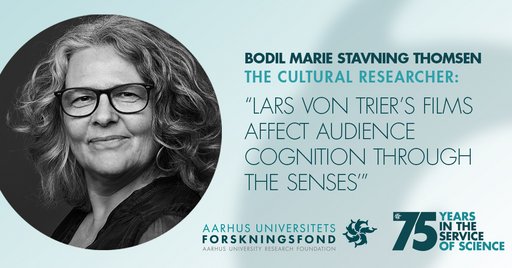
Professor Bodil Marie Stavning Thomsen conducts research into, amongst other things, the audio-visual expression of films. Blurry images and noise both play a bigger part in our experience than you might think.
My biggest Eureka moment was when in 2008, I worked across media with 'the signaletic material'. It is a term that defines the part of the media expression that calls the attention of the audience to the materiality of film, television, and digital media and technologies. With the 'signaletic material' I was able to connect forms of aesthetic-ethical sensation and crosswise thinking. I focused on the expressive element in blurry images and various kinds of noise. In doing so, I was able to contribute with analyses of how so-called haptic audio-visual forms expand the character theory in significant ways. This laid the foundation for my work on several book projects and for my current research project 'Affects, Interfaces, Events'.
What led to my realisation was when in the 1980s, I read Gilles Deleuze's film books. He replaced representative and stylistic analyses of media and arts with philosophical readings of how our senses can be linked to a qualitative time consciousness. That realisation inspired me to the research project 'Reality, Realism, the Real in Visual Perspective' which I was heading from 1999 to 2002. Here, seven researchers worked with new forms of realism, and I worked mainly with haptic images in electronic and digital media. This is where I began the analysis of how Lars von Trier's films directly and sensually affect our cognition ability – what in technical terms, we call affective cognition.
I felt most lost in the mid-1990s, when I was not yet a full-time employee and where the academic environment did not yet recognise aesthetic and philosophical cultural analyses across media and arts.
I knew I wanted to work within my field when I was well underway with my dissertation, which was submitted in 1982. It was an image-aesthetic study of a group exhibition at the Aarhus Art Museum. It prompted me a few years later to apply for a postgraduate fellowship in fashion and modernity which looked at fashion as a visual medium that required an aesthetic-cultural analysis. The project expanded the style-historical analyses of fashion and led to many lectures as a lot of people were interested in understanding fashion in a new way.
My research is relevant to other people because across cultural phenomena, it can demonstrate how media are created and shaped in and through cultures, and how cultures are affected by and changed through media. This is important for anyone with knowledge of how visual and audio-visual forms such as fashion and films play a part in today’s social media.
I received support from the Foundation for the release of Filmdivaer: Stjernens figur i Hollywoods melodrama 1920-40 (Film Divas: The Character of the Star in the Hollywood Melodrama 1920-40) in 1997, but I have also received support for more recent releases, including Lars von Trier's Renewal of Film 1984-2014: Signal, pixel, diagram in 2016. The support from the Foundation meant that the books could be published in an academic format that was also educational and illustrated with pictures.
I am most proud of my work when I see that my analyses and my perspectives are used and quoted by others. It is a pleasure to be used as an assessor of dissertations and in employments at home and abroad and to receive professional response at conferences and in other professional contexts. But the very best thing is when students find inspiration for their own analyses.
Right now, I am studying how the digital interface works in the culture, and how it influences both communication and art forms affectively. It is not just about the way in which interfaces in e.g. social media take part in media events or how interface media are changing democratic structures. It is also about understanding how the interface intensification of the affective level can create events and cultural connections across time and space.
BIOGRAPHY
Bodil Marie Stavning Thomsen
Professor MSO in culture and media at Nordic Institute, Aarhus University.
Master of Arts in Danish 1982 and PhD in cultural studies 1994.
Support from Aarhus University Research Foundation for the release of, amongst other things, Filmdivaer: Stjernens figur i Hollywoods melodrama 1920-40 (Film Divas: The Character of the Star in the Hollywood Melodrama 1920-40) in 1997 and Lars von Trier’s Renewal of Film. Signal-Pixel-Diagram in 2016.